Transient Two-Phase Flow in Porous Media: A Literature Review and Engineering Application in Geotechnics
Abstract
1. Introduction
2. Soil Suction and Soil Water Retention Behaviour
2.1. Multiphase Physics and Definition of Soil Suction
2.2. Soil Water Retention Curve
2.3. Soil Water Retention Function
2.4. Problems in Soil Water Retention Behaviour
- The SWRC variation of deformable soil because of hydro-mechanical loading;
- Hysteresis of SWRC additionally involving stiffness variation of deformable soil caused by hysteresis and densification of collapsing soil induced by hysteresis;
- The time-dependent change of SWRC because of wetting phase reconfiguration at transient state.
3. Steady-State and Transient Two-Phase Flow Seepage Theories
3.1. Richards Model
3.2. Hydraulic Conductivity Function
3.3. Green-Ampt Model
3.4. Buckley and Leverett Model
4. Review of Conventional Experiments in Continuum Scale
4.1. The Conventional Experiments of Soil Water Retention Curve
- Fast and ease of installation (ensure tip contact condition)
- Applicability in both laboratory and field (in situ) condition
- Short responding time (less than 1 min for low suction capacity micro-tensiometer)
- Long-term measurement (ensure no drain out of water in the shaft)
4.2. The Conventional Experiments of Hydraulic Conductivity Function
- Each suction increase interval must be small enough, so kunsat can be assumed as a constant in this interval (which requires meticulous suction control);
- The relation between soil suction and water content is linear (but, in fact, it is not only nonlinear but also hysteresis);
- HAE ceramic disk does not cause any hydraulic resistivity (but it is a significant impedance, especially for high permeable sandy soil);
- Flow is just one dimension;
- The gravity effect can be ignored;
- The testing specimen is homogeneous and nondeformable (which is only available for sandy soil).
5. Limitations of Conventional Theories and Experimental Methods
5.1. The Experimental Exploration of Dynamic Nonequilibrium Effects
- The dynamic effects are not significant in fine-textured soil;
- The higher rate of water content variation, the more significant the dynamic effects;
- The dynamic effects are more significant in coarse-textured sand;
- The dynamic effects in primary drainage curves are more significant than the dynamic effects in main drainage curves.
5.2. The Theoretical Paradoxes of Transient Two-Phase Flow Seepage
5.3. The Physical Causes for Dynamic Nonequilibrium Effects
6. Advanced Theories of Transient Two-Phase Flow Seepage
6.1. The Theory of Dynamic Fluids Redistribution
6.2. The Theory of Dual-Fraction with Dynamic Fluids Redistribution
6.3. The Theory of Dual-Porosity and Dual-Permeability
6.4. The Theory of Dynamic Nonequilibrium Capillary Pressure
7. Novel Experimental and Numerical Contributions in Multiscale
- Macroscale 1D soil column experiments supported by pressure and moisture sensors with inversion analysis of the Richards and modified models;
- Microscale physical pore network model supported by imaging technique;
- Microscale numerical experiments using Pore Network Model (PNM, solving Poiseuille form capillary flow equation in artificial pore network), Direct Numerical Simulation (DNS, solving Navier–Stoke equation in artificial beads package) and Lattice Boltzmann Method (LBM, solving discretised Boltzmann equation in virtual particles package).
7.1. The State-of-Art of the Continuum-Scale Experiments
7.2. The Influential Factors in Dynamic Nonequilibrium Effect
7.3. The Validations of Advanced Theories against Experiments
7.4. The State-of-Art of the Micromodels
7.5. The State-of-Art of the Pore-Scale Simulations
- if the characteristic time of the applied boundary flow is larger than redistribution time, Darcy’s law is still applicable;
- otherwise, dynamic should be considered.
8. Engineering Applications in Unsaturated Soil Mechanics
8.1. Observation of Transient Effects in Natural Slopes
8.2. Transient Effects Coupled in Unsaturated Soil Effective Stress
8.3. Transient Effects Coupled in Unsaturated Soil Shear Strength
8.4. Transient Effects Coupled in Unsaturated Soil Deformation
8.5. Discussion on Practical Engineering Application
9. Conclusions
- (1)
- The conventional theory of transient two-phase flow in porous media is still valid for transient flow conditions only if the instantaneous equilibrium condition can be achieved by carefully controlling the boundary conditions of geotechnical tests.
- (2)
- There are still many research questions left for instantaneous equilibrium two-phase flow in porous media in terms of deformation coupled with hysteresis, the high suction range for soft soil, hysteretic hydraulic properties for problematic soil, etc.
- (3)
- The conventional experiments determine the soil water retention and hydraulic properties under the assumption of instantaneous equilibrium. However, when such an assumption is violated, the inversion analysis can still produce velocity-dependent hydraulic diffusivity. Lacking a physical basis, this scenario becomes a fitting process rather than a physical and experimental characterization.
- (4)
- Earlier experimental observations of dynamic nonequilibrium effects under transient two-phase flow conditions fostered the theoretical development for modelling such effects. Thus, it is expected to advance theories with more experimental findings in multiscale.
- (5)
- The four advanced theories have their advantages and disadvantages. The soil water redistribution model, dual-fraction model with soil water redistribution, and dual-porosity and dual-permeability model can simulate transient effects in multiscale. However, according to this listing sequence of models, the theoretical complexity increases with more parameters in the governing equations. Except that the soil water equilibration time can be straightforwardly determined using instrumented soil column test, other parameters can only be given by inverse modelling.
- (6)
- Compared to the previous three theories in soil hydrology, the thermodynamic-based theory can be applied to simulate both soil moisture dynamics and nonequilibrium soil suction under transient two-phase flow conditions. Therefore, it has a unique advantage for estimating the mechanical properties of unsaturated soil, whereas others neglect this critical application.
- (7)
- Modern continuum-scale experimental methods often incorporate soil suction and moisture sensors into a soil column with various hydraulic boundary conditions. In petroleum engineering, core flooding tests can be implemented with non-destructed measuring methods for fluid saturation (e.g., CT scan, Gamma-ray, outflow, etc.). Nevertheless, pore pressure transducers are irreplaceable for determining dynamic capillary pressure.
- (8)
- Recent continuum-scale experimental and numerical studies focus on investigating influential factors of dynamic nonequilibrium effects in terms of dynamic capillary coefficient. The influential factors mainly include properties of porous media, fluid properties, multiphase physical properties, etc. However, many conflicting conclusions were drawn amongst those studies for each influential factor, therefore, needing more experimental revisits. Furthermore, the hysteretic and extreme conditions for dynamic effects should be continuously investigated using experimental and numerical methods in the future.
- (9)
- All advanced theories have been validated successfully by many experimental studies on specific hydraulic loading paths. However, there are failure cases, which might be due to numerical solution, parameter selection, etc. So, it is still worth casting the numerical tools constantly in order to improve the accuracy of numerical solutions. Moreover, the fingering flow simulated by the thermodynamic-based theory considering hysteresis could be due to conditionally numerical instability, which is quite debatable for mathematicians and numerical modellers.
- (10)
- The pore-scale modelling transient two-phase flow displacement can be achieved by the physical micromodel, numerical Pore-Network Model (PNM), and Computational Fluid Dynamic (CFD) method. Each is a powerful tool to investigate transient two-phase flow from pore-scale up to Representative Elementary Volume (REV) scale or even several REVs. Still, the physical micromodel is not often available in every geotechnical laboratory and is not generic. On the other hand, the Dynamic PNM (DPNM) can simulate the dynamic effects with lower computational expenses than CFD. However, the interfacial dynamics was not counted at pore-scale. Therefore, only local heterogeneities induced dynamic/transient effects can be reproduced by DPNM.
- (11)
- CFD methods include multiphase Lattice Boltzmann Method (LBM), Direct Numerical Simulation (DNS) coupled with Volume of Fluid (VoF) or Level-Set (LS), and Smoothed Particle Hydrodynamics (SPH). Only a few numerical experiments using those methods already replicated dynamic effects in dynamic capillarity, capillary-viscous and inertial dominating flow conditions. Although those numerical methods have been implemented to study steady-state flow conditions in flow patterns and regimes, the contribution to dynamic effects under transient flow conditions are still rare and, therefore, strongly urge pursuit in the future.
- (12)
- The observation of dynamic nonequilibrium effects in natural slopes was firstly reported in the recent literature. It partially supports the application of transient effects for engineering practices. However, the in-situ data are still insufficient to prove the importance of considering dynamic effects in modelling transient two-phase flow seepage. It is expected to receive more contributions from the field or large-scale observations than smaller-scale findings using the pressure or flow cell tests.
- (13)
- The dynamic/transient effects have been coupled into unsaturated soil effective stress, soil suction characteristic stress, subsequently in shear strength, and pore-elastic consolidation. Those studies proposed the theoretical frameworks for hydro-mechanical coupling with transient effects and succeeded in simulating nonequilibrium transient water flow in unsaturated soil. However, the validation can only be given to the transient seepage, while the mechanical prediction cannot be verified by any experimental results yet.
- (14)
- There are many challenges in setting up an experimental apparatus to test the mechanical properties of unsaturated soil under transient flow conditions. An inevitable drawback is the irreplaceability of tensiometers in detecting nonequilibrium soil suction. The insertions of those sensors will cause mechanical properties variation in terms of deformation. Moreover, deformation-induced nonuniqueness of soil water retention curve will dramatically increase complexity for additional coupling with transient effects. Therefore, those reasons constrain hydro-mechanical investigation when transient effects are considered. However, it seems still applicable for shear strength estimation and extreme equilibrium analysis when the soil pore matrix varies insignificantly.
Funding
Institutional Review Board Statement
Informed Consent Statement
Data Availability Statement
Acknowledgments
Conflicts of Interest
References
- Lu, N.; Likos, W.J. Unsaturated Soil Mechanics; John Wiley & Sons: Hoboken, NJ, USA, 2004. [Google Scholar]
- Fredlund, D.G.; Rahardjo, H. Soil Mechanics for Unsaturated Soils; John Wiley & Sons: New York, NY, USA, 1993. [Google Scholar]
- Skiftestad, K. Numerical Modelling of Microbial Enhanced Oil Recovery with Focus on Dynamic Effects: An Iterative Approach; Universitetet i Bergen (UiB): Bergen, Norway, 2015. [Google Scholar]
- Ng, C.; Shi, Q. A numerical investigation of the stability of unsaturated soil slopes subjected to transient seepage. Comput. Geotech. 1998, 22, 1–28. [Google Scholar] [CrossRef]
- Narasimhan, T. Buckingham, 1907. Vadose Zone J. 2005, 4, 434–441. [Google Scholar] [CrossRef]
- Richards, L.A. Capillary conduction of liquids through porous medium. Physics 1931, 1, 318–333. [Google Scholar] [CrossRef]
- Bear, J. Dynamics of Fluids in Porous Media. Soil Sci. 1975, 120, 162–163. [Google Scholar] [CrossRef]
- Buckley, S.; Leverett, M. Mechanism of Fluid Displacement in Sands. Trans. AIME 1942, 146, 107–116. [Google Scholar] [CrossRef]
- Pedroso, D.M. A consistent u-p formulation for porous media with hysteresis. Int. J. Numer. Methods Eng. 2015, 101, 606–634. [Google Scholar] [CrossRef]
- Richards, S.J.; Weeks, L.V. Capillary Conductivity Values from Moisture Yield and Tension Measurements on Soil Columns. Soil Sci. Soc. Am. J. 1953, 17, 206–209. [Google Scholar] [CrossRef]
- Tracy, F. Clean two-and three-dimensional analytical solutions of Richards’ equation for testing numerical solvers. Water Resour. Res. 2006, 42. [Google Scholar] [CrossRef]
- Celia, M.A.; Bouloutas, E.T.; Zarba, R.L. A general mass-conservative numerical solution for the unsaturated flow equation. Water Resour. Res. 1990, 26, 1483–1496. [Google Scholar] [CrossRef]
- Brooks, R.H. Hydraulic Properties of Porous Media. 1964. Available online: https://mountainscholar.org/bitstream/handle/10217/61288/HydrologyPapers_n3.pdf (accessed on 7 December 2021).
- Van Genuchten, M.T. A Closed-form Equation for Predicting the Hydraulic Conductivity of Unsaturated Soils. Soil Sci. Soc. Am. J. 1980, 44, 892–898. [Google Scholar] [CrossRef]
- Fredlund, D.; Xing, A. Equations for the soil-water characteristic curve. Can. Geotech. J. 1994, 31, 521–532. [Google Scholar] [CrossRef]
- Fredlund, D.; Xing, A.; Huang, S. Predicting the permeability function for unsaturated soils using the soil-water characteristic curve. Can. Geotech. J. 1994, 31, 533–546. [Google Scholar] [CrossRef]
- Mualem, Y. A new model for predicting the hydraulic conductivity of unsaturated porous media. Water Resour. Res. 1976, 12, 513–522. [Google Scholar] [CrossRef]
- Mualem, Y. Hydraulic conductivity of unsaturated porous media: Generalized macroscopic approach. Water Resour. Res. 1978, 14, 325–334. [Google Scholar] [CrossRef]
- Pedroso, D.M.; Williams, D.J. A novel approach for modelling soil–water characteristic curves with hysteresis. Comput. Geotech. 2010, 37, 374–380. [Google Scholar] [CrossRef]
- Pedroso, D.M.; Williams, D.J. Automatic calibration of soil–water characteristic curves using genetic algorithms. Comput. Geotech. 2011, 38, 330–340. [Google Scholar] [CrossRef]
- Topp, G.C.; Klute, A.; Peters, D.B. Comparison of Water Content-Pressure Head Data Obtained by Equilibrium, Steady-State, and Unsteady-State Methods. Soil Sci. Soc. Am. J. 1967, 31, 312–314. [Google Scholar] [CrossRef]
- Hassanizadeh, S.M.; Celia, M.A.; Dahle, H.K. Dynamic effect in the capillary pressure–saturation relationship and its impacts on unsaturated flow. Vadose Zone J. 2002, 1, 38–57. [Google Scholar]
- Nielsen, D.R.; Biggar, J.W.; Davidson, J.M. Experimental Consideration of Diffusion Analysis in Unsaturated Flow Problems. Soil Sci. Soc. Am. J. 1962, 26, 107–111. [Google Scholar] [CrossRef]
- Liakopoulos, A.C. Transient Flow through Unsaturated Porous Media; University of California: Berkeley, CA, USA, 1964. [Google Scholar]
- Schultze, B.; Ippisch, O.; Huwe, B.; Durner, W. Dynamic nonequilibrium during unsaturated water flow. In Proceedings of the International Workshop on Characterization and Measurement of the Hydraulic Properties of Unsaturated Porous Media, University of California, Riverside, CA, USA, 22–24 October 1997; pp. 877–892. [Google Scholar]
- Nielsen, P.; Perrochet, P. Watertable dynamics under capillary fringes: Experiments and modelling. Adv. Water Resour. 2000, 23, 503–515. [Google Scholar] [CrossRef][Green Version]
- Wildenschild, D.; Hopmans, J.; Simunek, J. Flow Rate Dependence of Soil Hydraulic Characteristics. Soil Sci. Soc. Am. J. 2001, 65, 35–48. [Google Scholar] [CrossRef]
- O’Carroll, D.M.; Phelan, T.J.; Abriola, L.M. Exploring dynamic effects in capillary pressure in multistep outflow experiments. Water Resour. Res. 2005, 41. [Google Scholar] [CrossRef]
- Schembre, J.M.; Kovscek, A.R. Estimation of Dynamic Relative Permeability and Capillary Pressure from Countercurrent Imbibition Experiments. Transp. Porous Media 2006, 65, 31–51. [Google Scholar] [CrossRef]
- Sakaki, T.; O’Carroll, D.M.; Illangasekare, T. Direct Quantification of Dynamic Effects in Capillary Pressure for Drainage–Wetting Cycles. Vadose Zone J. 2010, 9, 424–437. [Google Scholar] [CrossRef]
- Hui, C.; Changfu, W.; Huafeng, C.; Erlin, W.; Huan, L. Dynamic Capillary Effect and Its Impact on the Residual Water Content in Unsaturated Soils. In Proceedings of the GeoFlorida 2010: Advances in Analysis, Modeling and Design, West Palm Beach, FL, USA, 20–24 February 2010; pp. 328–337. [Google Scholar]
- Bottero, S.; Hassanizadeh, S.M.; Kleingeld, P.; Bezuijen, A.; Binning, P. Experimental study of dynamic capillary pressure effect in two-phase flow in porous media. In Proceedings of the XVI International Conference on Computational Methods in Water Resources (CMWR), Copenhagen, Denmark, 18–22 June 2006; pp. 18–22. [Google Scholar]
- Bottero, S.; Hassanizadeh, S.M.; Kleingeld, P.J.; Heimovaara, T. Nonequilibrium capillarity effects in two-phase flow through porous media at different scales. Water Resour. Res. 2011, 47. [Google Scholar] [CrossRef]
- Abidoye, L.; Das, D.B. Scale dependent dynamic capillary pressure effect for two-phase flow in porous media. Adv. Water Resour. 2014, 74, 212–230. [Google Scholar] [CrossRef]
- Mirzaei, M.; Das, D.B. Dynamic effects in capillary pressure–saturations relationships for two-phase flow in 3D porous media: Implications of micro-heterogeneities. Chem. Eng. Sci. 2007, 62, 1927–1947. [Google Scholar] [CrossRef]
- Vogel, H.-J.; Samouëlian, A.; Ippisch, O. Multi-step and two-step experiments in heterogeneous porous media to evaluate the relevance of dynamic effects. Adv. Water Resour. 2008, 31, 181–188. [Google Scholar] [CrossRef]
- Stauffer, F. Time dependence of the relations between capillary pressure, water content and conductivity during drainage of porous media. In Proceedings of the IAHR Symposium on Scale Effects in Porous Media, Thessaloniki, Greece, 29 August–1 September 1978; pp. 3.35–33.53. [Google Scholar]
- Joekar-Niasar, V.; Hassanizadeh, S.M.; Dahle, H.K. Non-equilibrium effects in capillarity and interfacial area in two-phase flow: Dynamic pore-network modelling. J. Fluid Mech. 2010, 655, 38–71. [Google Scholar] [CrossRef]
- Goel, G.; O’Carroll, D.M. Experimental investigation of nonequilibrium capillarity effects: Fluid viscosity effects. Water Resour. Res. 2011, 47. [Google Scholar] [CrossRef]
- Manthey, S.; Hassanizadeh, S.M.; Helmig, R. Macro-Scale Dynamic Effects in Homogeneous and Heterogeneous Porous Media. Transp. Porous Media 2005, 58, 121–145. [Google Scholar] [CrossRef]
- Hanspal, N.S.; Das, D.B. Dynamic effects on capillary pressure–Saturation relationships for two-phase porous flow: Implications of temperature. AIChE J. 2012, 58, 1951–1965. [Google Scholar] [CrossRef]
- Lovoll, G.; Jankov, M.; Måløy, K.J.; Toussaint, R.; Schmittbuhl, J.; Schäfer, G.; Méheust, Y. Influence of Viscous Fingering on Dynamic Saturation–Pressure Curves in Porous Media. Transp. Porous Media 2010, 86, 305–324. [Google Scholar] [CrossRef]
- Hassanizadeh, S.M.; Gray, W.G. Toward an improved description of the physics of two-phase flow. Adv. Water Resour. 1993, 16, 53–67. [Google Scholar] [CrossRef]
- Kalaydjian, F. A macroscopic description of multiphase flow in porous media involving spacetime evolution of fluid/fluid interface. Transp. Porous Media 1987, 2, 537–552. [Google Scholar] [CrossRef]
- Barenblatt, G.I.; Vinnichenko, A. Non-equilibrium seepage of immiscible fluids. Adv. Mech. 1980, 3, 35–50. [Google Scholar]
- Yan, G.; Bore, T.; Li, Z.; Schlaeger, S.; Scheuermann, A.; Li, L. Application of Spatial Time Domain Reflectometry for Investigating Moisture Content Dynamics in Unsaturated Loamy Sand for Gravitational Drainage. Appl. Sci. 2021, 11, 2994. [Google Scholar] [CrossRef]
- Zhuang, L.; Hassanizadeh, S.M.; Qin, C.-Z.; De Waal, A. Experimental Investigation of Hysteretic Dynamic Capillarity Effect in Unsaturated Flow. Water Resour. Res. 2017, 53, 9078–9088. [Google Scholar] [CrossRef]
- Zhuang, L.; van Duijn, C.; Hassanizadeh, S.M. The Effect of Dynamic Capillarity in Modeling Saturation Overshoot during Infiltration. Vadose Zone J. 2019, 18, 1–14. [Google Scholar] [CrossRef]
- Diamantopoulos, E.; Durner, W. Dynamic Nonequilibrium of Water Flow in Porous Media: A Review. Vadose Zone J. 2012, 11, vzj2011.0197. [Google Scholar] [CrossRef]
- Li, Y.; Luo, H.; Li, H.; Liu, X.; Tan, Y.; Chen, S.; Cai, J. A brief review of dynamic capillarity effect and its characteristics in low permeability and tight reservoirs. J. Pet. Sci. Eng. 2020, 189, 106959. [Google Scholar] [CrossRef]
- Karadimitriou, N.; Hassanizadeh, S.M.; Joekar-Niasar, V.; Kleingeld, P. Micromodel study of two-phase flow under transient conditions: Quantifying effects of specific interfacial area. Water Resour. Res. 2014, 50, 8125–8140. [Google Scholar] [CrossRef]
- Ferrari, A.; Lunati, I. Inertial effects during irreversible meniscus reconfiguration in angular pores. Adv. Water Resour. 2014, 74, 1–13. [Google Scholar] [CrossRef]
- Sivanesapillai, R.; Falkner, N.; Hartmaier, A.; Steeb, H. A CSF-SPH method for simulating drainage and imbibition at pore-scale resolution while tracking interfacial areas. Adv. Water Resour. 2016, 95, 212–234. [Google Scholar] [CrossRef]
- Yan, G.; Li, Z.; Bore, T.; Torres, S.; Scheuermann, A.; Li, L. Discovery of Dynamic Two-Phase Flow in Porous Media Using Two-Dimensional Multiphase Lattice Boltzmann Simulation. Energies 2021, 14, 4044. [Google Scholar] [CrossRef]
- Cao, Y.; Tang, M.; Zhang, Q.; Tang, J.; Lu, S. Dynamic capillary pressure analysis of tight sandstone based on digital rock model. Capilarity 2020, 3, 28–35. [Google Scholar] [CrossRef]
- Tang, M.; Lu, S.; Zhan, H.; Wenqjie, G.; Ma, H. The effect of a microscale fracture on dynamic capillary pressure of two-phase flow in porous media. Adv. Water Resour. 2018, 113, 272–284. [Google Scholar] [CrossRef]
- Khalili, N.; Khabbaz, M.H. A unique relationship for chi for the determination of the shear strength of unsaturated soils. Geotechnique 1998, 48, 681–687. [Google Scholar] [CrossRef]
- Vanapalli, S.K.; Fredlund, D.G. Comparison of Different Procedures to Predict Unsaturated Soil Shear Strength. Adv. Unsaturated Geotech. 2000, 195–209. [Google Scholar] [CrossRef]
- Fredlund, D.G.; Morgenstern, N.R. Stress state variables for unsaturated soils. J. Geotech. Geoenviron. Eng. 1977, 103. [Google Scholar] [CrossRef]
- Lu, N.; Likos, W.J. Suction Stress Characteristic Curve for Unsaturated Soil. J. Geotech. Geoenviron. Eng. 2006, 132, 131–142. [Google Scholar] [CrossRef]
- Alonso, E.E.; Gens, A.; Josa, A. A constitutive model for partially saturated soils. Géotechnique 1990, 40, 405–430. [Google Scholar] [CrossRef]
- Zhang, X.; Li, L. Limitations in the Constitutive Modeling of Unsaturated Soils and Solutions. Int. J. Geomech. 2011, 11, 174–185. [Google Scholar] [CrossRef]
- D’Onza, F.; Galllipoli, D.; Wheeler, S.; Casini, F.; Vaunat, J.; Khalili, N.; Laloui, L.; Masin, D.; Nuth, M.; Pereira, J. Benchmark of constituive models for unsaturated soils. Géotechnique 2011, 61, 283–302. [Google Scholar] [CrossRef]
- Sheng, D.; Zhang, S.; Yu, Z. Unanswered questions in unsaturated soil mechanics. Sci. China Ser. E Technol. Sci. 2013, 56, 1257–1272. [Google Scholar] [CrossRef]
- Hu, R.; Chen, Y.-F.; Liu, H.-H.; Zhou, C. A water retention curve and unsaturated hydraulic conductivity model for deformable soils: Consideration of the change in pore-size distribution. Géotechnique 2013, 63, 1389–1405. [Google Scholar] [CrossRef]
- Bordoni, M.; Bittelli, M.; Valentino, R.; Chersich, S.; Meisina, C. Improving the estimation of complete field soil water characteristic curves through field monitoring data. J. Hydrol. 2017, 552, 283–305. [Google Scholar] [CrossRef]
- Tian, S.; Lei, G.; He, S.; Yang, L. Dynamic effect of capillary pressure in low permeability reservoirs. Pet. Explor. Dev. 2012, 39, 405–411. [Google Scholar] [CrossRef]
- Shaw, D.J.; Costello, B. Introduction to colloid and surface chemistry (4th edition). Tribol. Int. 1993, 26, 222. [Google Scholar] [CrossRef]
- Jotisankasa, A. Collapse Behaviour of a Compacted Silty Clay; Imperial College London (University of London): London, UK, 2005. [Google Scholar]
- Scheuermann, A. Determination of the Soil Water Retention Curve or the Black Art of Getting a Realistic SWRC; Geotechnical Engineering Centre Workshop, School of Civil Engineering, University of Queensland: St. Lucia, QLD, Australia, 2014. [Google Scholar]
- Gardner, W.R. Mathematics of Isothermal Water Conduction in Unsaturated Soil; National Research Council (U.S.): Washington, DC, USA, 1958. [Google Scholar]
- Leong, E.C.; Rahardjo, H. Review of Soil-Water Characteristic Curve Equations. J. Geotech. Geoenviron. Eng. 1997, 123, 1106–1117. [Google Scholar] [CrossRef]
- Zhou, J.; Yu, J.-L. Influences affecting the soil-water characteristic curve. J. Zhejiang Univ.-Sci. A 2005, 6, 797–804. [Google Scholar] [CrossRef]
- Malaya, C.; Sreedeep, S. Critical Review on the Parameters Influencing Soil-Water Characteristic Curve. J. Irrig. Drain. Eng. 2012, 138, 55–62. [Google Scholar] [CrossRef]
- Liu, H.H.; Dane, J.H. Reconciliation between Measured and Theoretical Temperature Effects on Soil Water Retention Curves. Soil Sci. Soc. Am. J. 1993, 57, 1202–1207. [Google Scholar] [CrossRef]
- Romero, E.; Gens, A.; Lloret, A. Temperature effects on the hydraulic behaviour of an unsaturated clay. Geotech. Geol. Eng. 2001, 19, 311–332. [Google Scholar] [CrossRef]
- Zhou, A.-N.; Sheng, D.; Carter, J.P. Modelling the effect of initial density on soil-water characteristic curves. Géotechnique 2012, 62, 669–680. [Google Scholar] [CrossRef]
- Pham, H.Q.; Fredlund, D.G. Equations for the entire soil-water characteristic curve of a volume change soil. Can. Geotech. J. 2008, 45, 443–453. [Google Scholar] [CrossRef]
- Marinho, F.A.M. Nature of Soil–Water Characteristic Curve for Plastic Soils. J. Geotech. Geoenviron. Eng. 2005, 131, 654–661. [Google Scholar] [CrossRef]
- Gallipoli, D.; Wheeler, S.J.; Karstunen, M. Modelling the variation of degree of saturation in a deformable unsaturated soil. Géotechnique 2003, 53, 105–112. [Google Scholar] [CrossRef]
- Gallipoli, D. A hysteretic soil-water retention model accounting for cyclic variations of suction and void ratio. Géotechnique 2012, 62, 605–616. [Google Scholar] [CrossRef]
- Arroyo, H.; Rojas, E.; Pérez-Rea, M.D.L.L.; Horta, J.; Arroyo, J. A porous model to simulate the evolution of the soil–water characteristic curve with volumetric strains. C. R. Méc. 2015, 343, 264–274. [Google Scholar] [CrossRef]
- Fredlund, D.G.; Sheng, D.; Zhao, J. Estimation of soil suction from the soil-water characteristic curve. Can. Geotech. J. 2011, 48, 186–198. [Google Scholar] [CrossRef]
- Pham, H.Q.; Fredlund, D.G.; Barbour, S.L. A study of hysteresis models for soil-water characteristic curves. Can. Geotech. J. 2005, 42, 1548–1568. [Google Scholar] [CrossRef]
- Tsiampousi, A.; Zdravković, L.; Potts, D. A three-dimensional hysteretic soil-water retention curve. Géotechnique 2013, 63, 155–164. [Google Scholar] [CrossRef]
- Fredlund, M.D.; Wilson, G.W.; Fredlund, D.G. Use of the grain-size distribution for estimation of the soil-water characteristic curve. Can. Geotech. J. 2002, 39, 1103–1117. [Google Scholar] [CrossRef]
- Lee, T.-K.; Ro, H.-M. Estimating soil water retention function from its particle-size distribution. Geosci. J. 2014, 18, 219–230. [Google Scholar] [CrossRef]
- Perera, Y.Y.; Zapata, C.E.; Houston, W.N.; Houston, S.L. Prediction of the Soil-Water Characteristic Curve Based on Grain-Size-Distribution and Index Properties. Adv. Pavement Eng. 2005, 130, 49–60. [Google Scholar] [CrossRef]
- Rawls, W.J.; Brakensiek, D. Prediction of Soil Water Properties for Hydrologic Modeling. In Watershed Management in the Eighties; ASCE: Reston, VA, USA, 1985. [Google Scholar]
- Scheinost, A.; Sinowski, W.; Auerswald, K. Regionalization of soil water retention curves in a highly variable soilscape, I. Developing a new pedotransfer function. Geoderma 1997, 78, 129–143. [Google Scholar] [CrossRef]
- Aubertin, M.; Mbonimpa, M.; Bussière, B.; Chapuis, R.P. A model to predict the water retention curve from basic geotechnical properties. Can. Geotech. J. 2003, 40, 1104–1122. [Google Scholar] [CrossRef]
- Arya, L.M.; Paris, J.F. A physicoempirical model to predict the soil moisture characteristic from particle-size distribution and bulk density data. Soil Sci. Soc. Am. J. 1981, 45, 1023–1030. [Google Scholar] [CrossRef]
- Basile, A.; D’Urso, G. Experimental corrections of simplified methods for predicting water retention curves in clay-loamy soils from particle-size determination. Soil Technol. 1997, 10, 261–272. [Google Scholar] [CrossRef]
- Scheuermann, A.; Bieberstein, A. Determination of the Soil Water Retention Curve and the Unsaturated Hydraulic Conductivity from the Particle Size Distribution. In Experimental Unsaturated Soil Mechanics. Springer Proceedings in Physics; Springer: Berlin/Heidelberg, Germany, 2007; Volume 112, pp. 421–433. [Google Scholar] [CrossRef]
- Childs, E.C.; Collis-George, N. The permeability of porous materials. Proc. R. Soc. Lond. Ser. A Math. Phys. Sci. 1950, 201, 392–405. [Google Scholar] [CrossRef]
- Gardner, W.R. Some steady-state solutions of the unsaturated moisture flow equation with application to evaporation from a water table. Soil Sci. 1958, 85, 228–232. [Google Scholar] [CrossRef]
- Zhan, T.L.T.; Ng, C.W.W. Analytical Analysis of Rainfall Infiltration Mechanism in Unsaturated Soils. Int. J. Geomech. 2004, 4, 273–284. [Google Scholar] [CrossRef]
- Leij, F.J.; Russell, W.B.; Lesch, S.M. Closed-Form Expressions for Water Retention and Conductivity Data. Groundwater 1997, 35, 848–858. [Google Scholar] [CrossRef]
- Childs, E. Physical Basis of Soil Water Phenomena; John Wiley & Sons: Hoboken, NJ, USA, 1969. [Google Scholar]
- Green, W.H.; Ampt, G. Studies on soil physics, 1. The flow of air and water through soils. J. Agric. Sci. 1911, 4, 1–24. [Google Scholar]
- Kale, R.V.; Sahoo, B. Green-Ampt Infiltration Models for Varied Field Conditions: A Revisit. Water Resour. Manag. 2011, 25, 3505–3536. [Google Scholar] [CrossRef]
- Philip, J.R. The theory of infiltration: 4. Sorptivity and algebraic infiltration equations. Soil Sci. 1957, 84, 257–264. [Google Scholar] [CrossRef]
- ASTM D2216-10; Standard Test Methods for Laboratory Determination of Water (Moisture) Content of Soil and Rock by Mass. ASTM International: West Conshohocken, PA, USA, 2010.
- ASTM D5550-06; Standard Test Method for Specific Gravity of Soil Solids by Gas Pycnometer. ASTM International: West Conshohocken, PA, USA, 2006.
- ASTM D7263-09; Standard Test Method for Laboratory Determination of Density (Unit Weight) of Soil specimens. ASTM International: West Conshohocken, PA, USA, 2009.
- ASTM D4943-08; Standard Test Method for Shrinkage Factors of Soils by the Wax Method. ASTM International: West Conshohocken, PA, USA, 2008.
- ASTM D6836-02; Test Methods for Determination of the Soil Water Characteristic Curve for Desorption Using a Hanging Column, Pressure Extractor, Chilled Mirror Hygrometer, and/or Centrifuge. ASTM International: West Conshohocken, PA, USA, 2003.
- ASTM D7664-10; Standard Test Methods for Measurement of Hydraulic Conductivity of Unsaturated Soils. ASTM International: West Conshohocken, PA, USA, 2010.
- Haines, W.B. Studies in the physical properties of soil. V. The hysteresis effect in capillary properties, and the modes of moisture distribution associated therewith. J. Agric. Sci. 1930, 20, 97–116. [Google Scholar] [CrossRef]
- Vanapalli, S.K.; Nicotera, M.V.; Sharma, R.S. Axis Translation and Negative Water Column Techniques for Suction Control. Geotech. Geol. Eng. 2008, 26, 645–660. [Google Scholar] [CrossRef]
- Romano, N.; Hopmans, J.; Dane, J. 3.3. 2.6 Suction table. Methods Soil Anal. Part 2002, 4, 692–698. [Google Scholar]
- Lu, N.; Godt, J.W.; Wu, D.T. A closed-form equation for effective stress in unsaturated soil. Water Resour. Res. 2010, 46. [Google Scholar] [CrossRef]
- Gubiani, P.I.; Reichert, J.M.; Campbell, C.; Reinert, D.J.; Gelain, N.S. Assessing Errors and Accuracy in Dew-Point Potentiometer and Pressure Plate Extractor Meaurements. Soil Sci. Soc. Am. J. 2013, 77, 19–24. [Google Scholar] [CrossRef]
- Gardner, W.; Israelsen, O.W.; Edlefsen, N.E.; Clyde, D. The capillary potential function and its relation to irrigation practice. Phys. Rev. 1922, 20, 196. [Google Scholar]
- Toll, D.G.; Lourenço, S.D.; Mendes, J. Advances in suction measurements using high suction tensiometers. Eng. Geol. 2013, 165, 29–37. [Google Scholar] [CrossRef]
- UMS. User Manual of T5/T5x Pressure Transducer Tensiometer; Munchen, U.G., Ed.; METER Group AG: München, Germany, 2009. [Google Scholar]
- Masrouri, F.; Bicalho, K.V.; Kawai, K. Laboratory Hydraulic Testing in Unsaturated Soils. Geotech. Geol. Eng. 2008, 26, 691–704. [Google Scholar] [CrossRef]
- Olsen, H.W.; Willden, A.T.; Kiusalaas, N.J.; Nelson, K.R.; Poeter, E.P. Volume-Controlled Hydrologic Property Measurements in Triaxial Systems. In Hydraulic Conductivity and Waste Contaminant Transport in Soil; ASTM International: West Conshohocken, PA, USA, 2009; pp. 482–504. [Google Scholar] [CrossRef]
- Gardner, W.R. Calculation of Capillary Conductivity from Pressure Plate Outflow Data. Soil Sci. Soc. Am. J. 1956, 20, 317–320. [Google Scholar] [CrossRef]
- Bruce, R.R.; Klute, A. The Measurement of Soil Moisture Diffusivity. Soil Sci. Soc. Am. J. 1956, 20, 458–462. [Google Scholar] [CrossRef]
- Yan, G.; Li, Z.; Bore, T.; Scheuermann, A.; Galindo-Torres, S.; Li, L. The measurement of primary drainage curve using hanging column and large soil column test. In Proceedings of the GeoOttawa 2017, Ottawa, ON, Canada, 1–4 October 2017. [Google Scholar]
- O’Carroll, D.M.; Mumford, K.G.; Abriola, L.M.; Gerhard, J.I. Influence of wettability variations on dynamic effects in capillary pressure. Water Resour. Res. 2010, 46. [Google Scholar] [CrossRef]
- Rawlins, S.L.; Gardner, W.H. A Test of the Validity of the Diffusion Equation for Unsaturated Flow of Soil Water. Soil Sci. Soc. Am. J. 1963, 27, 507–511. [Google Scholar] [CrossRef]
- Tsakiroglou, C.D.; Theodoropoulou, M.A.; Karoutsos, V. Nonequilibrium capillary pressure and relative permeability curves of porous media. AIChE J. 2003, 49, 2472–2486. [Google Scholar] [CrossRef]
- Elzeftawy, A.; Mansell, R.S. Hydraulic Conductivity Calculations for Unsaturated Steady-State and Transient-State Flow in Sand. Soil Sci. Soc. Am. J. 1975, 39, 599–603. [Google Scholar] [CrossRef]
- Smiles, D.E.; Vachaud, G.; Vauclin, M. A Test of the Uniqueness of the Soil Moisture Characteristic During Transient, Nonhysteretic Flow of Water in a Rigid Soil. Soil Sci. Soc. Am. J. 1971, 35, 534–539. [Google Scholar] [CrossRef]
- Vachaud, G.; Vauclin, M.; Wakil, M. A Study of the Uniqueness of the Soil Moisture Characteristic During Desorption by Vertical Drainage. Soil Sci. Soc. Am. J. 1972, 36, 531–532. [Google Scholar] [CrossRef]
- Wana-Etyem, C. Static and Dynamic Water Content-Pressure Head Relations of Porous Media; Colorado State University: Fort Collins, CO, USA, 1982. [Google Scholar]
- Poulovassilis, A. The Uniqueness of the Moisture Characteristics. J. Soil Sci. 1974, 25, 27–33. [Google Scholar] [CrossRef]
- Weller, U.; Ippisch, O.; Köhne, M.; Vogel, H.-J. Direct Measurement of Unsaturated Conductivity including Hydraulic Nonequilibrium and Hysteresis. Vadose Zone J. 2011, 10, 654–661. [Google Scholar] [CrossRef]
- Weller, U.; Vogel, H.-J. Conductivity and Hydraulic Nonequilibrium across Drainage and Infiltration Fronts. Vadose Zone J. 2012, 11, vzj2011.0134. [Google Scholar] [CrossRef]
- Bohne, K.; Salzmann, W. Inverse simulation of non-steady-state evaporation using nonequilibrium water retention data: A case study. Geoderma 2002, 110, 49–62. [Google Scholar] [CrossRef]
- Gray, W.G.; Hassanizadeh, S.M. Paradoxes and Realities in Unsaturated Flow Theory. Water Resour. Res. 1991, 27, 1847–1854. [Google Scholar] [CrossRef]
- Bolt, G.H.; Miller, R.D. Calculation of total and component potentials of water in Soil. Trans. Am. Geophys. Union 1958, 39, 917–928. [Google Scholar] [CrossRef]
- Yang, D.; Krasowska, M.; Priest, C.; Popescu, M.N.; Ralston, J. Dynamics of Capillary-Driven Flow in Open Microchannels. J. Phys. Chem. C 2011, 115, 18761–18769. [Google Scholar] [CrossRef]
- Hoffman, R.L. A study of the advancing interface. I. Interface shape in liquid—gas systems. J. Colloid Interface Sci. 1975, 50, 228–241. [Google Scholar] [CrossRef]
- Kim, J.; Kim, H.-Y. On the dynamics of capillary imbibition. J. Mech. Sci. Technol. 2012, 26, 3795–3801. [Google Scholar] [CrossRef]
- Zhmud, B.; Tiberg, F.; Hallstensson, K. Dynamics of Capillary Rise. J. Colloid Interface Sci. 2000, 228, 263–269. [Google Scholar] [CrossRef] [PubMed]
- Sheng, P.; Zhou, M. Immiscible-fluid displacement: Contact-line dynamics and the velocity-dependent capillary pressure. Phys. Rev. A 1992, 45, 5694–5708. [Google Scholar] [CrossRef]
- Baver, C.E.; Parlange, J.Y.; Stoof, C.R.; DiCarlo, D.A.; Wallach, R.; Durnford, D.S.; Steenhuis, T.S. Capillary pressure overshoot for unstable wetting fronts is explained by Hoffman’s velocity-dependent contact-angle relationship. Water Resour. Res. 2014, 50, 5290–5297. [Google Scholar] [CrossRef]
- De Gennes, P.G. Dynamic Capillary Pressure in Porous Media. EPL Europhys. Lett. 1988, 5, 689–691. [Google Scholar] [CrossRef]
- Calvo, A.; Paterson, I.; Chertcoff, R.; Rosen, M.; Hulin, J.P. Dynamic capillary pressure variations in diphasic flows through glass capillaries. J. Colloid Interface Sci. 1991, 141, 384–394. [Google Scholar] [CrossRef]
- Bell, J.M.; Cameron, F.K. The Flow of Liquids through Capillary Spaces. J. Phys. Chem. 1906, 10, 658–674. [Google Scholar] [CrossRef]
- Lucas, R. Ueber das Zeitgesetz des kapillaren Aufstiegs von Flüssigkeiten. Colloid Polym. Sci. 1918, 23, 15–22. [Google Scholar] [CrossRef]
- Washburn, E.W. The Dynamics of Capillary Flow. Phys. Rev. 1921, 17, 273–283. [Google Scholar] [CrossRef]
- Weitz, D.A.; Stokes, J.P.; Ball, R.C.; Kushnick, A.P. Dynamic Capillary Pressure in Porous Media: Origin of the Viscous-Fingering Length Scale. Phys. Rev. Lett. 1987, 59, 2967–2970. [Google Scholar] [CrossRef]
- Hoffman, R.L. A study of the advancing interface: II. Theoretical prediction of the dynamic contact angle in liquid-gas systems. J. Colloid Interface Sci. 1983, 94, 470–486. [Google Scholar] [CrossRef]
- Hassanizadeh, S.M.; Gray, W.G. Thermodynamic basis of capillary pressure in porous media. Water Resour. Res. 1993, 29, 3389–3405. [Google Scholar] [CrossRef]
- Šimůnek, J.; Jarvis, N.J.; Van Genuchten, M.T.; Gärdenäs, A. Review and comparison of models for describing non-equilibrium and preferential flow and transport in the vadose zone. J. Hydrol. 2003, 272, 14–35. [Google Scholar] [CrossRef]
- Joekar-Niasar, V.; Hassanizadeh, S.M. Uniqueness of Specific Interfacial Area–Capillary Pressure–Saturation Relationship under Non-Equilibrium Conditions in Two-Phase Porous Media Flow. Transp. Porous Media 2012, 94, 465–486. [Google Scholar] [CrossRef]
- Barenblatt, G.I. Filtration of two nonmixing fluids in a homogeneous porous medium. Fluid Dyn. 1971, 6, 857–864. [Google Scholar] [CrossRef]
- Ross, P.J.; Smettem, K.R.J. A Simple Treatment of Physical Nonequilibrium Water Flow in Soils. Soil Sci. Soc. Am. J. 2000, 64, 1926–1930. [Google Scholar] [CrossRef]
- Diamantopoulos, E.; Iden, S.C.; Durner, W. Inverse modeling of dynamic nonequilibrium in water flow with an effective approach. Water Resour. Res. 2012, 48. [Google Scholar] [CrossRef]
- Philip, J.R. The theory of absorption in aggregated media. Soil Res. 1968, 6, 1–19. [Google Scholar] [CrossRef]
- Gerke, H.H.; Van Genuchten, M.T. A dual-porosity model for simulating the preferential movement of water and solutes in structured porous media. Water Resour. Res. 1993, 29, 305–319. [Google Scholar] [CrossRef]
- Gerke, H.H.; Van Genuchten, M.T. Evaluation of a first-order water transfer term for variably saturated dual-porosity flow models. Water Resour. Res. 1993, 29, 1225–1238. [Google Scholar] [CrossRef]
- Kalaydjian, F.J.-M. Dynamic capillary pressure curve for water/oil displacement in porous media: Theory vs. experiment. In Proceedings of the SPE Annual Technical Conference and Exhibition, Washington, DC, USA, 4–7 October 1992. [Google Scholar] [CrossRef]
- Barenblatt, G.I.; Patzek, T.W.; Silin, D.B. The Mathematical Model of Nonequilibrium Effects in Water-Oil Displacement. SPE J. 2003, 8, 409–416. [Google Scholar] [CrossRef]
- Šimůnek, J.; Endroth, O.W.; Wypler, N.; Van Genuchten, M.T. Non-equilibrium water flow characterized by means of upward infiltration experiments. Eur. J. Soil Sci. 2001, 52, 13–24. [Google Scholar] [CrossRef]
- Hassanizadeh, S.M.; Gray, W.G. General conservation equations for multi-phase systems: 1. Averaging procedure. Adv. Water Resour. 1979, 2, 131–144. [Google Scholar] [CrossRef]
- Luo, Z.; Kong, J.; Ji, Z.; Shen, C.; Lu, C.; Xin, P.; Zhao, Z.; Li, L.; Barry, D.A. Watertable fluctuation-induced variability in the water retention curve: Sand column experiments. J. Hydrol. 2020, 589, 125125. [Google Scholar] [CrossRef]
- Li, H.; Li, Y.; Chen, S.; Guo, J.; Wang, K.; Luo, H. Effects of Chemical Additives on Dynamic Capillary Pressure during Waterflooding in Low Permeability Reservoirs. Energy Fuels 2016, 30, 7082–7093. [Google Scholar] [CrossRef]
- Li, Y.; Li, H.; Chen, S.; Luo, H.; Liu, C. Investigation of the dynamic capillary pressure during displacement process in fractured tight rocks. AIChE J. 2020, 66, e16783. [Google Scholar] [CrossRef]
- Diamantopoulos, E.; Durner, W.; Iden, S.C.; Weller, U.; Vogel, H.-J. Modeling dynamic non-equilibrium water flow observations under various boundary conditions. J. Hydrol. 2015, 529, 1851–1858. [Google Scholar] [CrossRef]
- Sun, Y.; Li, Q.; Yang, D.; Liu, X. Laboratory core flooding experimental systems for CO2 geosequestration: An updated review over the past decade. J. Rock Mech. Geotech. Eng. 2016, 8, 113–126. [Google Scholar] [CrossRef]
- Das, D.B.; Mirzaei, M. Dynamic effects in capillary pressure relationships for two-phase flow in porous media: Experiments and numerical analyses. AIChE J. 2012, 58, 3891–3903. [Google Scholar] [CrossRef]
- Mirzaei, M.; Das, D.B. Experimental investigation of hysteretic dynamic effect in capillary pressure-saturation relationship for two-phase flow in porous media. AIChE J. 2013, 59, 3958–3974. [Google Scholar] [CrossRef]
- Bottero, S. Advances in the Theory of Capillarity in Porous Media; Geologica Ultraiectina (314) (Doctoral dissertation, Departement Aardwetenschappen); Wöhrmann Print Service: Zutphen, The Netherlands, 2009; ISBN 978-90-5744-175-7. [Google Scholar]
- Abidoye, L.K.; Das, D.B. Artificial neural network modeling of scale-dependent dynamic capillary pressure effects in two-phase flow in porous media. J. Hydroinform. 2015, 17, 446–461. [Google Scholar] [CrossRef]
- Goel, G.; Abidoye, L.K.; Chahar, B.R.; Das, D.B. Scale dependency of dynamic relative permeability–satuartion curves in relation with fluid viscosity and dynamic capillary pressure effect. Environ. Fluid Mech. 2016, 16, 945–963. [Google Scholar] [CrossRef]
- Civan, F. Temperature dependency of dynamic coefficient for nonequilibrium capillary pressure-saturation relationship. AIChE J. 2012, 58, 2282–2285. [Google Scholar] [CrossRef]
- Barenblatt, G.I.; Azorero, J.G.; De Pablo, A.; Vazquez, J.L. Mathematical model of the non equilibrium water oil displacement in porous strata. Appl. Anal. 1997, 65, 19–45. [Google Scholar] [CrossRef]
- Li, Y.; Luo, H.; Li, H.; Chen, S.; Jiang, X.; Li, J. Dynamic capillarity during displacement process in fractured tight reservoirs with multiple fluid viscosities. Energy Sci. Eng. 2019, 8, 300–311. [Google Scholar] [CrossRef]
- Abbasi, J.; Ghaedi, M.; Riazi, M. A new numerical approach for investigation of the effects of dynamic capillary pressure in imbibition process. J. Pet. Sci. Eng. 2018, 162, 44–54. [Google Scholar] [CrossRef]
- Helmig, R.; Weiss, A.; Wohlmuth, B.I. Dynamic capillary effects in heterogeneous porous media. Comput. Geosci. 2007, 11, 261–274. [Google Scholar] [CrossRef]
- Li, Y.; Li, H.; Chen, S.; Mbia, E.; Wang, K.; Ren, H. Capillarity characters measurement and effects analysis in different permeability formations during waterflooding. Fuel 2017, 194, 129–143. [Google Scholar] [CrossRef]
- Salimi, H.; Bruining, J. Upscaling of fractured oil reservoirs using homogenization including non-equilibrium capillary pressure and relative permeability. Comput. Geosci. 2012, 16, 367–389. [Google Scholar] [CrossRef]
- Mumford, K.G.; O’Carroll, D.M. Drainage under Nonequilibrium Conditions: Exploring Wettability and Dynamic Contact Angle Effects Using Bundle-Of-Tubes Simulations. Vadose Zone J. 2011, 10, 1162–1172. [Google Scholar] [CrossRef]
- Chen, L. Hysteresis and Dynamic Effects in the Relationship between Capillary Pressure, Saturation, and Air-Water Interfacial Area in Porous Media; The University of Oklahoma: Norman, OK, USA, 2006. [Google Scholar]
- Scheuermann, A.; Montenegro, H.; Bieberstein, A. Column test apparatus for the inverse estimation of soil hydraulic parameters under defined stress condition. In Unsaturated Soils: Experimental Studies; Springer: Berlin/Heidelberg, Germany, 2005; Volume 93, pp. 33–44. [Google Scholar]
- Scheuermann, A.; Galindo-Torres, S.A.; Pedroso, D.M.; Williams, D.J.; Li, L. Dynamics of water movements with reversals in unsaturated soils. In Unsaturated Soils: Research & Applications, Proceedings of the 6th International Conference on Unsaturated Soils (UNSAT 2014), Sydney, Australia, 2–4 July 2014; CRC Press: Boca Raton, FL, USA; pp. 1053–1059.
- Galindo-Torres, S.A.; Scheuermann, A.; Li, L.; Pedroso, D.M.; Williams, D.J. A Lattice Boltzmann model for studying transient effects during imbibition–drainage cycles in unsaturated soils. Comput. Phys. Commun. 2013, 184, 1086–1093. [Google Scholar] [CrossRef]
- Cartwright, N.; Nielsen, P.; Perrochet, P. Influence of capillarity on a simple harmonic oscillating water table: Sand column experiments and modeling. Water Resour. Res. 2005, 41. [Google Scholar] [CrossRef]
- Cartwright, N. Moisture-pressure dynamics above an oscillating water table. J. Hydrol. 2014, 512, 442–446. [Google Scholar] [CrossRef][Green Version]
- Chen, P.; Wei, C.; Yi, P.; Ma, T. Determination of Hydraulic Properties of Unsaturated Soils Based on Nonequilibrium Multistep Outflow Experiments. J. Geotech. Geoenviron. Eng. 2017, 143, 04016087. [Google Scholar] [CrossRef]
- Lo, W.-C.; Yang, C.-C.; Hsu, S.-Y.; Chen, C.-H.; Yeh, C.-L.; Hilpert, M. The dynamic response of the water retention curve in unsaturated soils during drainage to acoustic excitations. Water Resour. Res. 2017, 53, 712–725. [Google Scholar] [CrossRef]
- Zhou, D.; Jia, L.; Kamath, J. An investigation of counter-current imbibition processes in diatomite. In Proceedings of the SPE Western Regional Meeting, Bakersfield, CA, USA, 26–30 March 2001. [Google Scholar]
- Le Guen, S.S.; Kovscek, A.R. Nonequilibrium Effects During Spontaneous Imbibition. Transp. Porous Media 2006, 63, 127–146. [Google Scholar] [CrossRef]
- Zhou, D.; Jia, L.; Kamath, J.; Kovscek, A.R. Scaling of counter-current imbibition processes in low-permeability porous media. J. Pet. Sci. Eng. 2002, 33, 61–74. [Google Scholar] [CrossRef]
- Jarvis, N.J. A review of non-equilibrium water flow and solute transport in soil macropores: Principles, controlling factors and consequences for water quality. Eur. J. Soil Sci. 2007, 58, 523–546. [Google Scholar] [CrossRef]
- Sander, G.C.; Glidewell, O.J.; Norbury, J. Dynamic capillary pressure, hysteresis and gravity-driven fingering in porous media. J. Phys. Conf. Ser. 2008, 138, 012023. [Google Scholar] [CrossRef]
- Cao, X.; Pop, I.S. Two-phase porous media flows with dynamic capillary effects and hysteresis: Uniqueness of weak solutions. Comput. Math. Appl. 2015, 69, 688–695. [Google Scholar] [CrossRef]
- El-Amin, M.F. Stability Analysis of the Modified IMPES Scheme for Two–Phase Flow in Porous Media Including Dynamic Capillary Pressure. Procedia Comput. Sci. 2017, 108, 2328–2332. [Google Scholar] [CrossRef]
- Das, D.B.; Gill, B.S.; Abidoye, L.K.; Khudaida, K.J. A numerical study of dynamic capillary pressure effect for supercritical carbon dioxide-water flow in porous domain. AIChE J. 2014, 60, 4266–4278. [Google Scholar] [CrossRef]
- Hou, L.; Sleep, B.E.; Kibbey, T.C. The influence of unavoidable saturation averaging on the experimental measurement of dynamic capillary effects: A numerical simulation study. Adv. Water Resour. 2014, 66, 43–51. [Google Scholar] [CrossRef]
- Fučík, R.; Mikyška, J. Numerical investigation of dynamic capillary pressure in two-phase flow in porous medium. Math. Bohem. 2011, 136, 395–403. [Google Scholar] [CrossRef]
- Zhang, H.; He, S.; Jiao, C.; Luan, G.; Mo, S.; Guo, X. Determination of dynamic relative permeability in ultra-low permeability sandstones via X-ray CT technique. J. Pet. Explor. Prod. Technol. 2014, 4, 443–455. [Google Scholar] [CrossRef][Green Version]
- Ren, G.; Rafiee, J.; Aryana, S.A.; Younis, R.M. A Bayesian model selection analysis of equilibrium and nonequilibrium models for multiphase flow in porous media. Int. J. Multiph. Flow 2017, 89, 313–320. [Google Scholar] [CrossRef]
- Zhuang, L.; Hassanizadeh, S.M.; Van Genuchten, M.T.; Leijnse, A.; Raoof, A.; Qin, C. Modeling of Horizontal Water Redistribution in an Unsaturated Soil. Vadose Zone J. 2016, 15. [Google Scholar] [CrossRef]
- Zhuang, L.; Hassanizadeh, S.M.; Kleingeld, P.J.; Van Genuchten, M.T. Revisiting the horizontal redistribution of water in soils: Experiments and numerical modeling. Water Resour. Res. 2017, 53, 7576–7589. [Google Scholar] [CrossRef]
- DiCarlo, D.A. Experimental measurements of saturation overshoot on infiltration. Water Resour. Res. 2004, 40. [Google Scholar] [CrossRef]
- Fritz, S. Experimental Investigations of Water Infiltration into Unsaturated Soil: Analysis of Dynamic Capillarity Effects. Master’s Thesis, University of Stuttgart, Stuttgart, Germany, July 2012. [Google Scholar]
- Zhuang, L.; Hassanizadeh, S.M.; Bhatt, D.; van Duijn, C.J. Spontaneous Imbibition and Drainage of Water in a Thin Porous Layer: Experiments and Modeling. Transp. Porous Media 2021, 139, 381–396. [Google Scholar] [CrossRef]
- Tsakiroglou, C.D.; Avraam, D.G.; Payatakes, A.C. Transient and steady-state relative permeabilities from two-phase flow experiments in planar pore networks. Adv. Water Resour. 2007, 30, 1981–1992. [Google Scholar] [CrossRef]
- Karadimitriou, N.K.; Musterd, M.; Kleingeld, P.J.; Kreutzer, M.T.; Hassanizadeh, S.M.; Joekar-Niasar, V. On the fabrication of PDMS micromodels by rapid prototyping, and their use in two-phase flow studies. Water Resour. Res. 2013, 49, 2056–2067. [Google Scholar] [CrossRef]
- Chen, J.D.; Wilkinson, D. Pore-Scale Viscous Fingering in Porous Media. Phys. Rev. Lett. 1985, 55, 1892–1895. [Google Scholar] [CrossRef]
- Lenormand, R.; Touboul, E.; Zarcone, C. Numerical models and experiments on immiscible displacements in porous media. J. Fluid Mech. 1988, 189, 165–187. [Google Scholar] [CrossRef]
- Avraam, D.G.; Payatakes, A.C. Flow Mechanisms, Relative Permeabilities, and Coupling Effects in Steady-State Two-Phase Flow through Porous Media. The Case of Strong Wettability. Ind. Eng. Chem. Res. 1999, 38, 778–786. [Google Scholar] [CrossRef]
- Pyrak-Nolte, L.J.; Nolte, D.D.; Chen, D.; Giordano, N.J. Relating capillary pressure to interfacial areas. Water Resour. Res. 2008, 44. [Google Scholar] [CrossRef]
- Karadimitriou, N.K.; Hassanizadeh, S.M. A Review of Micromodels and Their Use in Two-Phase Flow Studies. Vadose Zone J. 2012, 11, vzj2011.0072. [Google Scholar] [CrossRef]
- Karadimitriou, N.K.; Joekar-Niasar, V.; Hassanizadeh, S.M.; Kleingeld, P.J.; Pyrak-Nolte, L.J. A novel deep reactive ion etched (DRIE) glass micro-model for two-phase flow experiments. Lab Chip 2012, 12, 3413–3418. [Google Scholar] [CrossRef] [PubMed]
- Kunz, P.; Zarikos, I.M.; Karadimitriou, N.K.; Huber, M.; Nieken, U.; Hassanizadeh, S.M. Study of Multi-phase Flow in Porous Media: Comparison of SPH Simulations with Micro-model Experiments. Transp. Porous Media 2015, 114, 581–600. [Google Scholar] [CrossRef]
- Nuske, P.; Ronneberger, O.; Karadimitriou, N.K.; Helmig, R.; Hassanizadeh, S.M. Modeling two-phase flow in a micro-model with local thermal non-equilibrium on the Darcy scale. Int. J. Heat Mass Transf. 2015, 88, 822–835. [Google Scholar] [CrossRef]
- Konangi, S.; Palakurthi, N.K.; Karadimitriou, N.K.; Comer, K.; Ghia, U. Comparison of pore-scale capillary pressure to macroscale capillary pressure using direct numerical simulations of drainage under dynamic and quasi-static conditions. Adv. Water Resour. 2021, 147, 103792. [Google Scholar] [CrossRef]
- Yiotis, A.; Karadimitriou, N.K.; Zarikos, I.; Steeb, H. Pore-scale effects during the transition from capillary- to viscosity-dominated flow dynamics within microfluidic porous-like domains. Sci. Rep. 2021, 11, 3891. [Google Scholar] [CrossRef] [PubMed]
- Joekar-Niasar, V.; Hassanizadeh, S.M.; Leijnse, A. Insights into the Relationships Among Capillary Pressure, Saturation, Interfacial Area and Relative Permeability Using Pore-Network Modeling. Transp. Porous Media 2008, 74, 201–219. [Google Scholar] [CrossRef]
- Joekar-Niasar, V.; Hassanizadeh, S.M.; Pyrak-Nolte, L.J.; Berentsen, C. Simulating drainage and imbibition experiments in a high-porosity micromodel using an unstructured pore network model. Water Resour. Res. 2009, 45. [Google Scholar] [CrossRef]
- Joekar-Niasar, V.; Hassanizadeh, S.M. Specific interfacial area: The missing state variable in two-phase flow equations? Water Resour. Res. 2011, 47. [Google Scholar] [CrossRef]
- Sweijen, T.; Hassanizadeh, S.M.; Chareyre, B.; Zhuang, L. Dynamic Pore-Scale Model of Drainage in Granular Porous Media: The Pore-Unit Assembly Method. Water Resour. Res. 2018, 54, 4193–4213. [Google Scholar] [CrossRef]
- Joekar-Niasar, V.; Hassanizadeh, S.M. Analysis of Fundamentals of Two-Phase Flow in Porous Media Using Dynamic Pore-Network Models: A Review. Crit. Rev. Environ. Sci. Technol. 2012, 42, 1895–1976. [Google Scholar] [CrossRef]
- Sukop, M.C.; Thorne, D.T., Jr. Lattice Boltzmann Modeling: An Introduction for Geoscientists and Engineers; Springer: Berlin/Heidelberg, Germany, 2007. [Google Scholar]
- Sukop, M.C.; Thorne, D.T., Jr. Lattice Boltzmann Modeling; Springer: Berlin/Heidelberg, Germany, 2006. [Google Scholar]
- Shan, X.; Chen, H. Lattice Boltzmann model for simulating flows with multiple phases and components. Phys. Rev. E 1993, 47, 1815–1819. [Google Scholar] [CrossRef] [PubMed]
- Sukop, M.C.; Or, D. Lattice Boltzmann method for modeling liquid-vapor interface configurations in porous media. Water Resour. Res. 2004, 40. [Google Scholar] [CrossRef]
- Pan, C.; Hilpert, M.; Miller, C.T. Lattice-Boltzmann simulation of two-phase flow in porous media. Water Resour. Res. 2004, 40. [Google Scholar] [CrossRef]
- Ahrenholz, B.; Tölke, J.; Lehmann, P.; Peters, A.; Kaestner, A.; Krafczyk, M.; Durner, W. Prediction of capillary hysteresis in a porous material using lattice-Boltzmann methods and comparison to experimental data and a morphological pore network model. Adv. Water Resour. 2008, 31, 1151–1173. [Google Scholar] [CrossRef]
- Porter, M.L.; Schaap, M.G.; Wildenschild, D. Lattice-Boltzmann simulations of the capillary pressure–saturation–interfacial area relationship for porous media. Adv. Water Resour. 2009, 32, 1632–1640. [Google Scholar] [CrossRef]
- Galindo-Torres, S.A.; Scheuermann, A.; Pedroso, D.M.; Li, L. Effect of boundary conditions on measured water retention behavior within soils. In Proceedings of the AGU Fall Meeting, San Francisco, CA, USA, 9–13 December 2013; p. H43F-1516. [Google Scholar]
- Landry, C.J.; Karpyn, Z.T.; Ayala, O. Relative permeability of homogenous-wet and mixed-wet porous media as determined by pore-scale lattice Boltzmann modeling. Water Resour. Res. 2014, 50, 3672–3689. [Google Scholar] [CrossRef]
- Hatiboglu, C.U.; Babadagli, T. Pore-scale studies of spontaneous imbibition into oil-saturated porous media. Phys. Rev. E 2008, 77, 066311. [Google Scholar] [CrossRef]
- Jiang, F.; Tsuji, T. Changes in pore geometry and relative permeability caused by carbonate precipitation in porous media. Phys. Rev. E 2014, 90, 053306. [Google Scholar] [CrossRef]
- Schaap, M.G.; Porter, M.L.; Christensen, B.S.B.; Wildenschild, D. Comparison of pressure-saturation characteristics derived from computed tomography and lattice Boltzmann simulations. Water Resour. Res. 2007, 43. [Google Scholar] [CrossRef]
- Yin, P.; Zhao, G.F. Numerical study of two-phase fluid distributions in fractured porous media. Int. J. Numer. Anal. Methods Geomech. 2015, 39, 1188–1211. [Google Scholar] [CrossRef]
- Liu, H.; Valocchi, A.J.; Werth, C.; Kang, Q.; Oostrom, M. Pore-scale simulation of liquid CO2 displacement of water using a two-phase lattice Boltzmann model. Adv. Water Resour. 2014, 73, 144–158. [Google Scholar] [CrossRef]
- Liu, H.; Zhang, Y.; Valocchi, A.J. Lattice Boltzmann simulation of immiscible fluid displacement in porous media: Homogeneous versus heterogeneous pore network. Phys. Fluids 2015, 27, 052103. [Google Scholar] [CrossRef]
- Fan, L.; Fang, H.; Lin, Z. Simulation of contact line dynamics in a two-dimensional capillary tube by the lattice Boltzmann model. Phys. Rev. E 2001, 63, 051603. [Google Scholar] [CrossRef]
- Raiskinmäki, P.; Shakib-Manesh, A.; Jäsberg, A.; Koponen, A.; Merikoski, J.; Timonen, J. Lattice-Boltzmann Simulation of Capillary Rise Dynamics. J. Stat. Phys. 2002, 107, 143–158. [Google Scholar] [CrossRef]
- Ferrari, A.; Lunati, I. Direct numerical simulations of interface dynamics to link capillary pressure and total surface energy. Adv. Water Resour. 2013, 57, 19–31. [Google Scholar] [CrossRef]
- Ferrari, A.; Jimenez-Martinez, J.; Borgne, T.L.; Méheust, Y.; Lunati, I. Challenges in modeling unstable two-phase flow experiments in porous micromodels. Water Resour. Res. 2015, 51, 1381–1400. [Google Scholar] [CrossRef]
- Ferrari, A. Pore-Scale Modeling of Two-Phase Flow Instabilities in Porous Media; University of Torino: Turin, Italy, 2014. [Google Scholar]
- Helland, J.O.; Friis, H.A.; Jettestuen, E.; Skjaeveland, S.M. Footprints of spontaneous fluid redistribution on capillary pressure in porous rock. Geophys. Res. Lett. 2017, 44, 4933–4943. [Google Scholar] [CrossRef]
- Sivanesapillai, R.; Steeb, H. Fluid Interfaces during Viscous-Dominated Primary Drainage in 2D Micromodels Using Pore-Scale SPH Simulations. Geofluids 2018, 2018, 8269645. [Google Scholar] [CrossRef]
- Lins, Y.; Schanz, T.; Fredlund, D.G. Modified Pressure Plate Apparatus and Column Testing Device for Measuring SWCC of Sand. Geotech. Test. J. 2009, 32, 450–464. [Google Scholar] [CrossRef]
- Ng, C.W.W.; Leung, A.K. Measurements of Drying and Wetting Permeability Functions Using a New Stress-Controllable Soil Column. J. Geotech. Geoenviron. Eng. 2012, 138, 58–68. [Google Scholar] [CrossRef]
- Dong, Y.; Lu, N.; Wayllace, A.; Smits, K. Measurement of Thermal Conductivity Function of Unsaturated Soil Using a Transient Water Release and Imbibition Method. Geotech. Test. J. 2014, 37, 980–990. [Google Scholar] [CrossRef]
- Durner, W.; Diamantopoulos, E.; Iden, S.C.; Scharnagl, B. Hydraulic Properties and Non-equilibrium Water Flow in Soils. In Application of Soil Physics in Environmental Analyses; Springer: Cham, Switzerland, 2014; pp. 403–434. [Google Scholar] [CrossRef]
- Ng, C.W.W.; Zhan, L.T.; Bao, C.G.; Fredlund, D.G.; Gong, B.W. Performance of an unsaturated expansive soil slope subjected to artificial rainfall infiltration. Geotechnique 2003, 53, 143–157. [Google Scholar] [CrossRef]
- Bishop, A.W. The Principles of Effective Stress. Teknisk Ukeblad 1959, 39, 859–863. [Google Scholar]
- Richards, B.G. The significance of moisture flow and equilibria in unsaturated soils in relation to the design of engineering structures built on shallow foundations in Australia. 1966. [Google Scholar]
- Aitchison, G.D. Soils properties, shear strength, and consolidation. In Proceedings of the 6th International Conference on Soil Mechanics and Foundation Engineering, Montreal, QC, Canada, 8–15 September 1965; University of Toronto Press: Toronto, ON, Canada; pp. 318–321. [Google Scholar]
- Nikooee, E.; Habibagahi, G.; Hassanizadeh, S.M.; Ghahramani, A. Effective Stress in Unsaturated Soils: A Thermodynamic Approach Based on the Interfacial Energy and Hydromechanical Coupling. Transp. Porous Media 2012, 96, 369–396. [Google Scholar] [CrossRef]
- Nikooee, E.; Hassanizadeh, S.M.; Habibagahi, G. Mechanics of unsaturated soils: From equilibrium to transient conditions. In Proceedings of the Poromechanics V: The Fifth Biot Conference on Poromechanics, Vienna, Austria, 10–12 July 2013; pp. 2049–2058. [Google Scholar] [CrossRef]
- Milatz, M.; Törzs, T.; Grabe, J. Investigation of transient effects on the soil–water characteristic curve of different granular soils. In Proceedings of the 7th International Conference on Unsaturated Soils (UNSAT 2018), Hong Kong, China, 3–5 August 2018; pp. 355–360. [Google Scholar]
- Milatz, M.; Grabe, J. A New Simple Shear Apparatus and Testing Method for Unsaturated Sands. Geotech. Test. J. 2014, 38, 9–22. [Google Scholar] [CrossRef]
- Milatz, M.; Törzs, T.; Nikooee, E.; Hassanizadeh, S.M.; Grabe, J. Theoretical and experimental investigations on the role of transient effects in the water retention behaviour of unsaturated granular soils. Geomech. Energy Environ. 2018, 15, 54–64. [Google Scholar] [CrossRef]
- Milatz, M.; Törzs, T.; Grabe, J. Settlements in unsaturated granular soils induced by changes in saturation and suction. In Proceedings of 3rd European Conference on Unsaturated Soils (E-UNSAT 2016), E3S Web of Conferences; EDP Sciences: Les Ulis, France, 2016; Volume 9, No. 14009; pp. 1–7. [Google Scholar] [CrossRef]
- Zou, Y.; Saad, M.; Grondin, F. Numerical investigation for the effect of deformation and dynamic pressure on the fast drainage of porous materials. Eur. J. Environ. Civ. Eng. 2021, 1–20. [Google Scholar] [CrossRef]
- Biot, M.A. General Theory of Three-Dimensional Consolidation. J. Appl. Phys. 1941, 12, 155–164. [Google Scholar] [CrossRef]
- Biot, M.A.; Willis, D.G. The Elastic Coefficients of the Theory of Consolidation. J. Appl. Mech. 1957, 24, 594–601. [Google Scholar] [CrossRef]
- Wang, X.; Nackenhorst, U. A coupled bio-chemo-hydraulic model to predict porosity and permeability reduction during microbially induced calcite precipitation. Adv. Water Resour. 2020, 140, 103563. [Google Scholar] [CrossRef]
- Morel-Seytoux, H.J.; Meyer, P.D.; Nachabe, M.; Tourna, J.; Van Genuchten, M.T.; Lenhard, R.J. Parameter Equivalence for the Brooks-Corey and Van Genuchten Soil Characteristics: Preserving the Effective Capillary Drive. Water Resour. Res. 1996, 32, 1251–1258. [Google Scholar] [CrossRef]
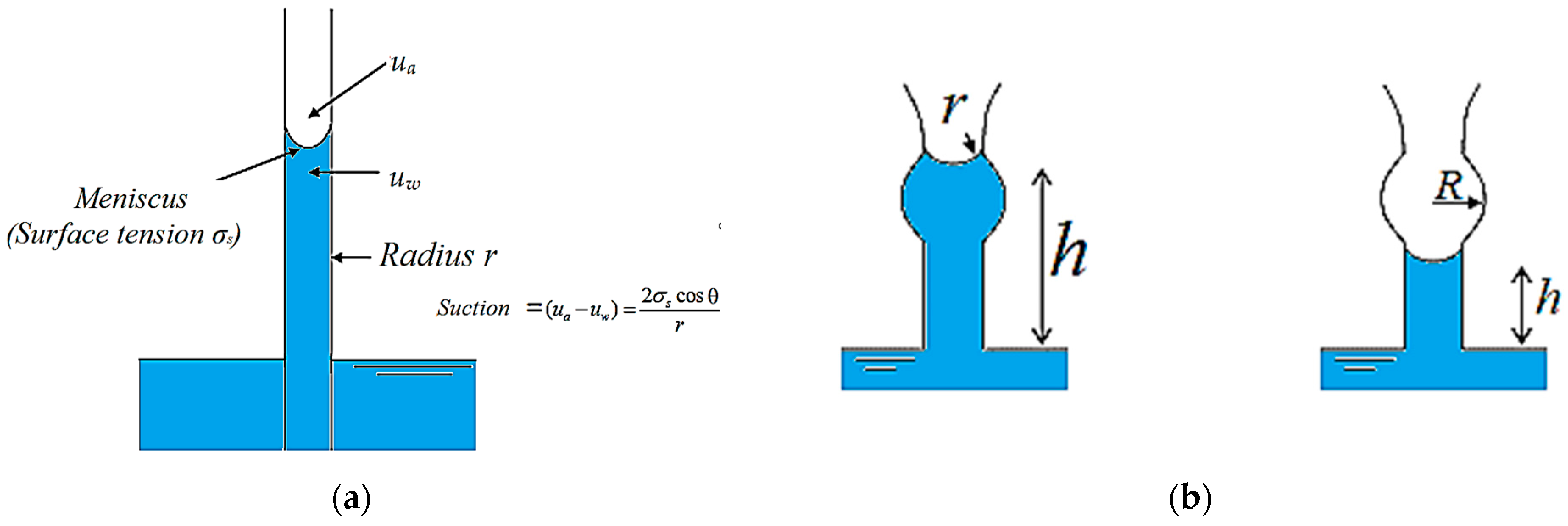
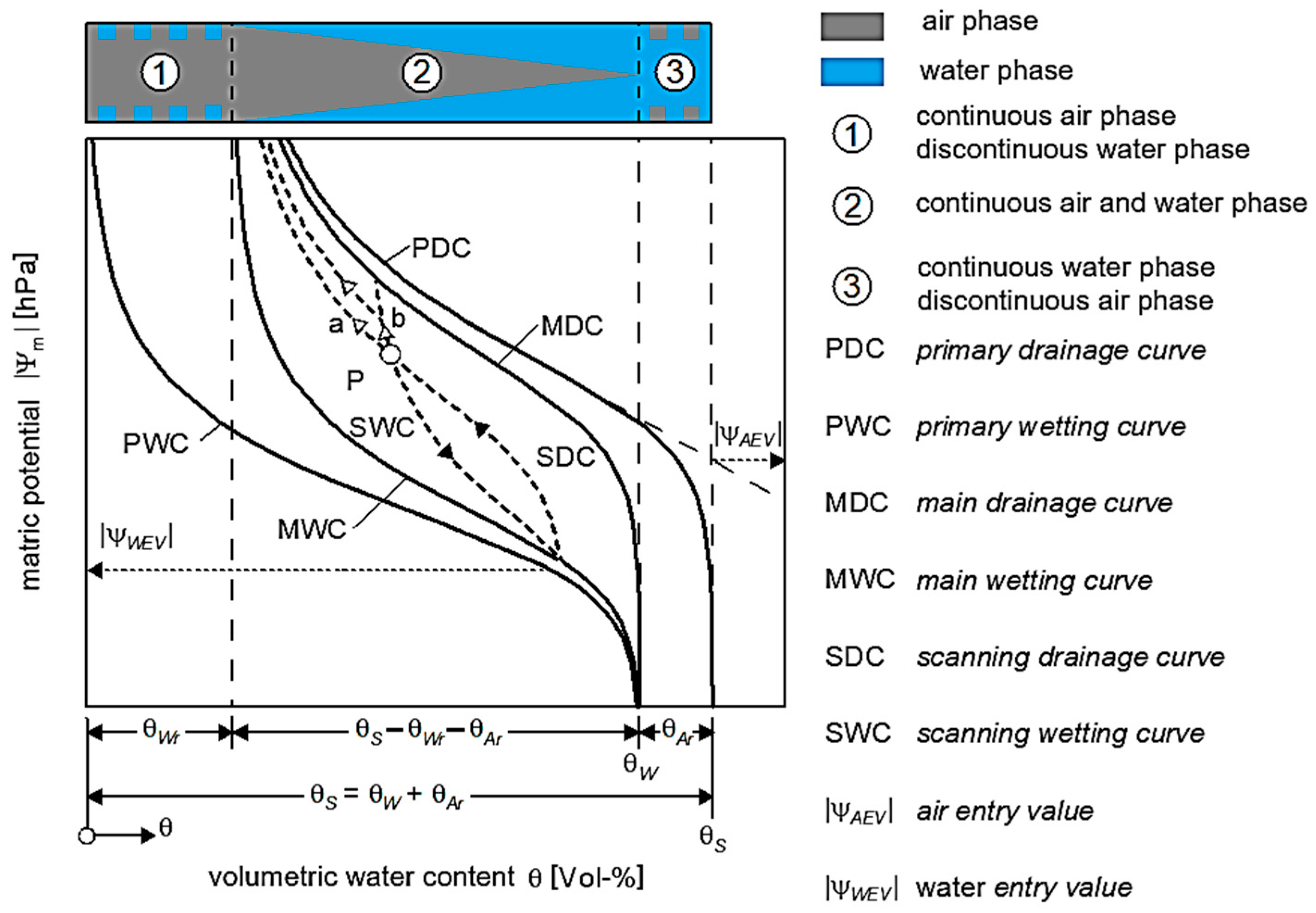
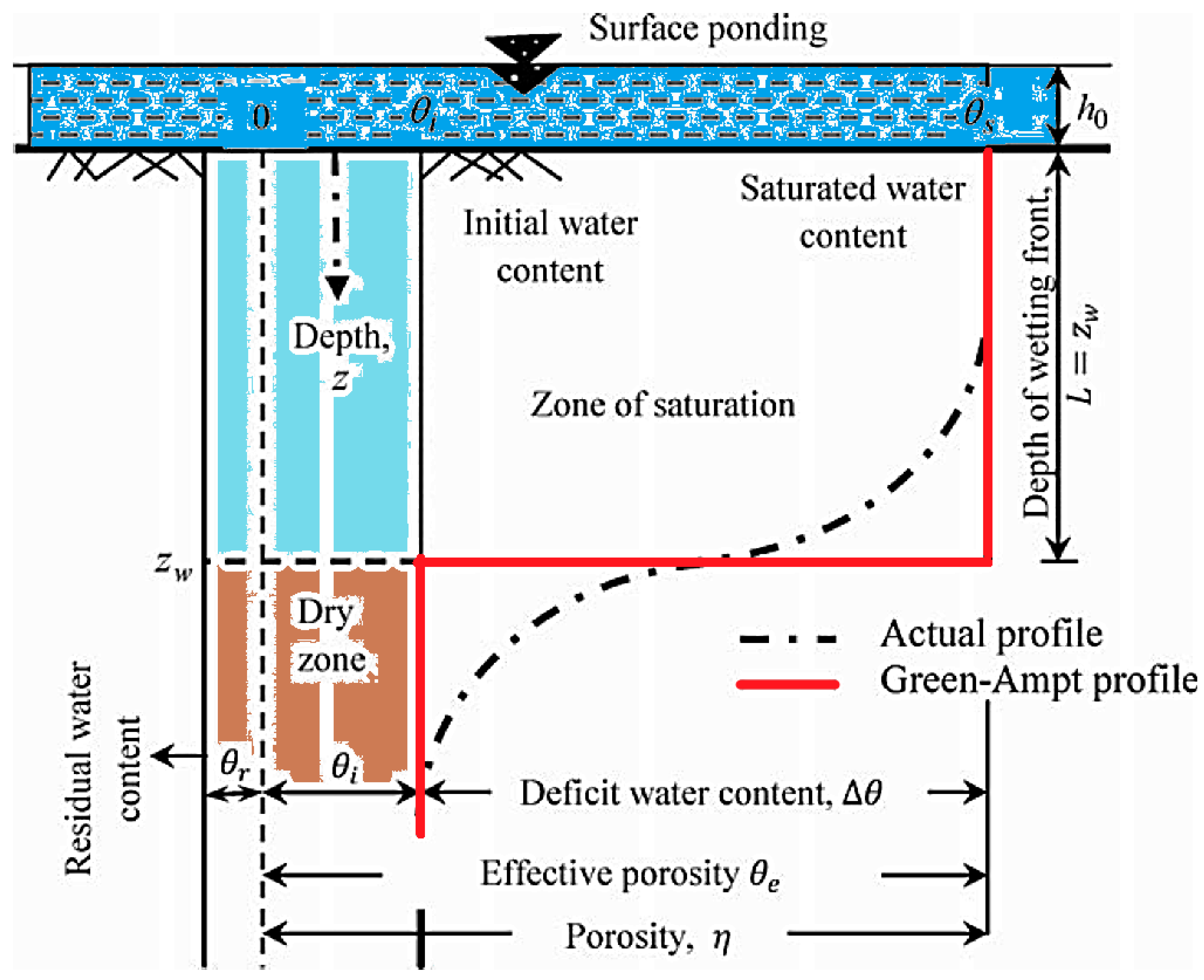
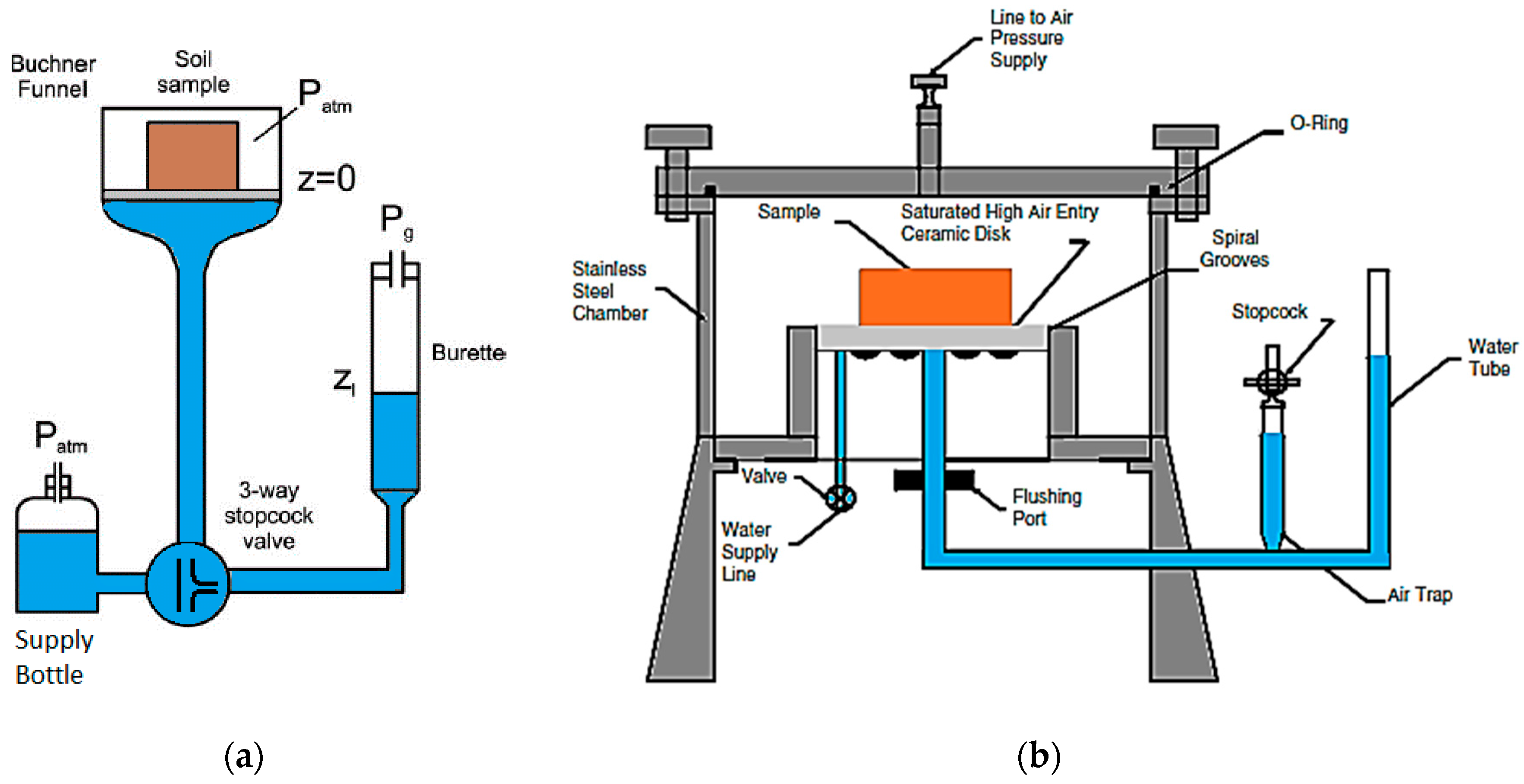
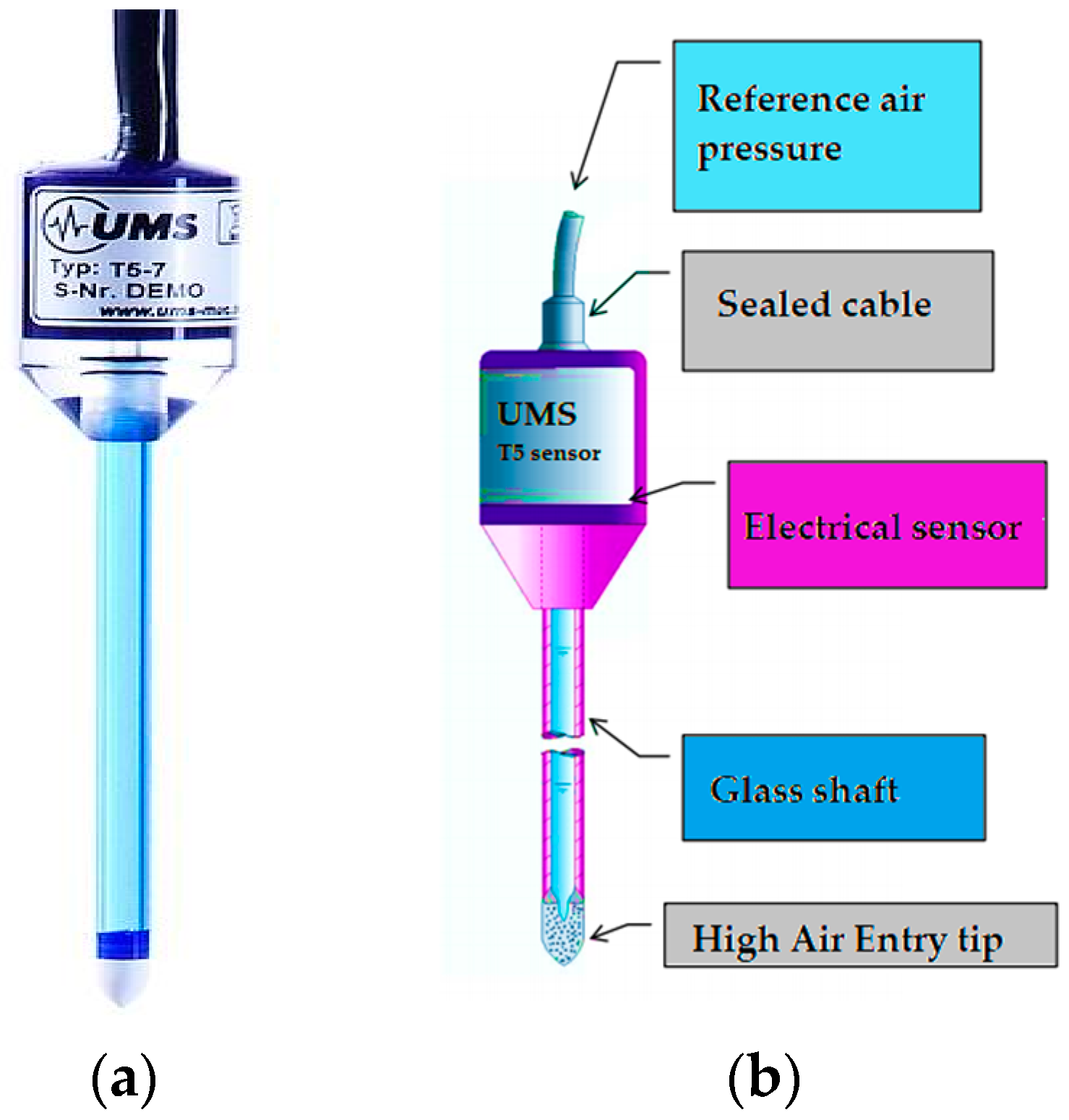
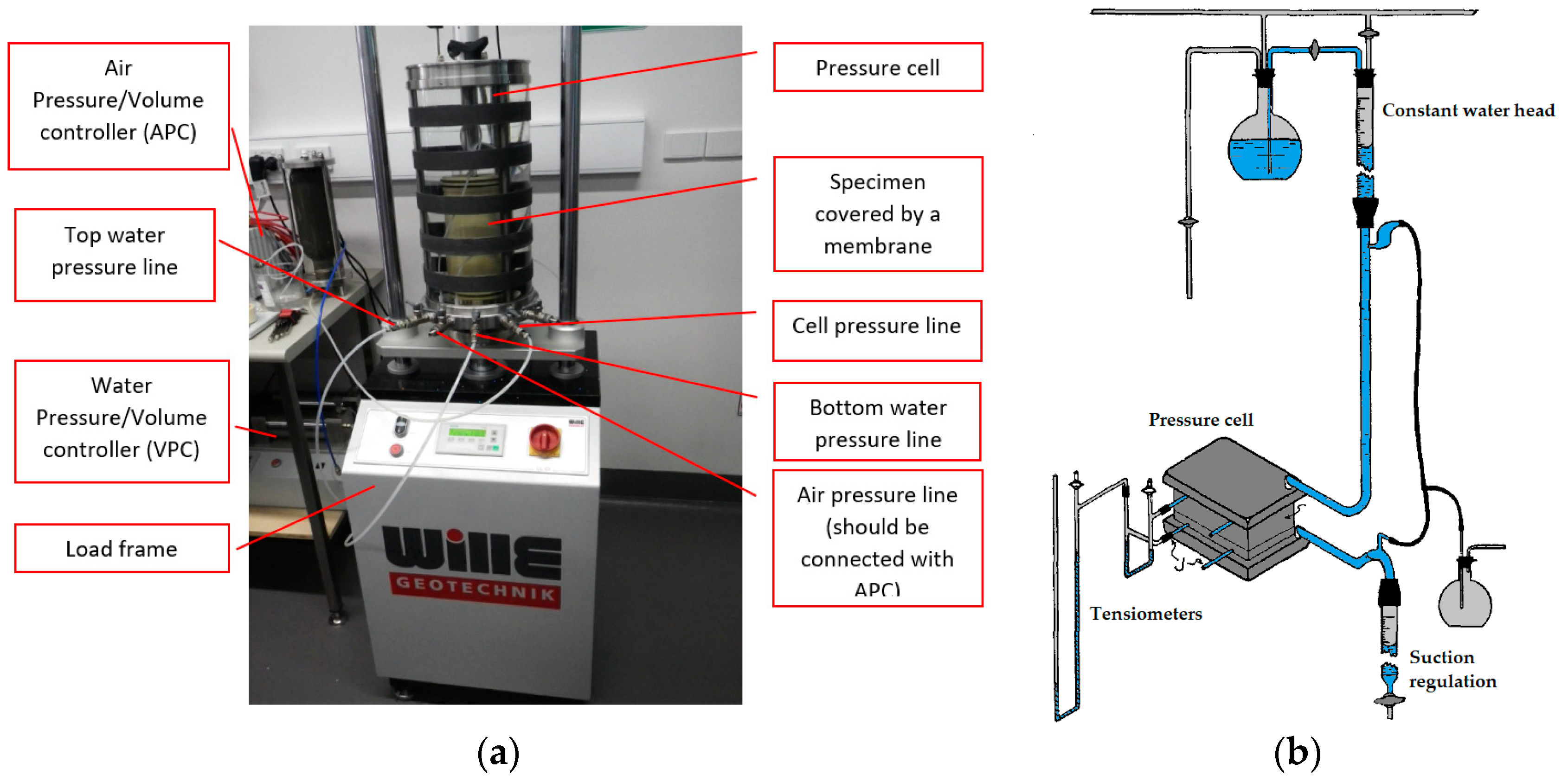

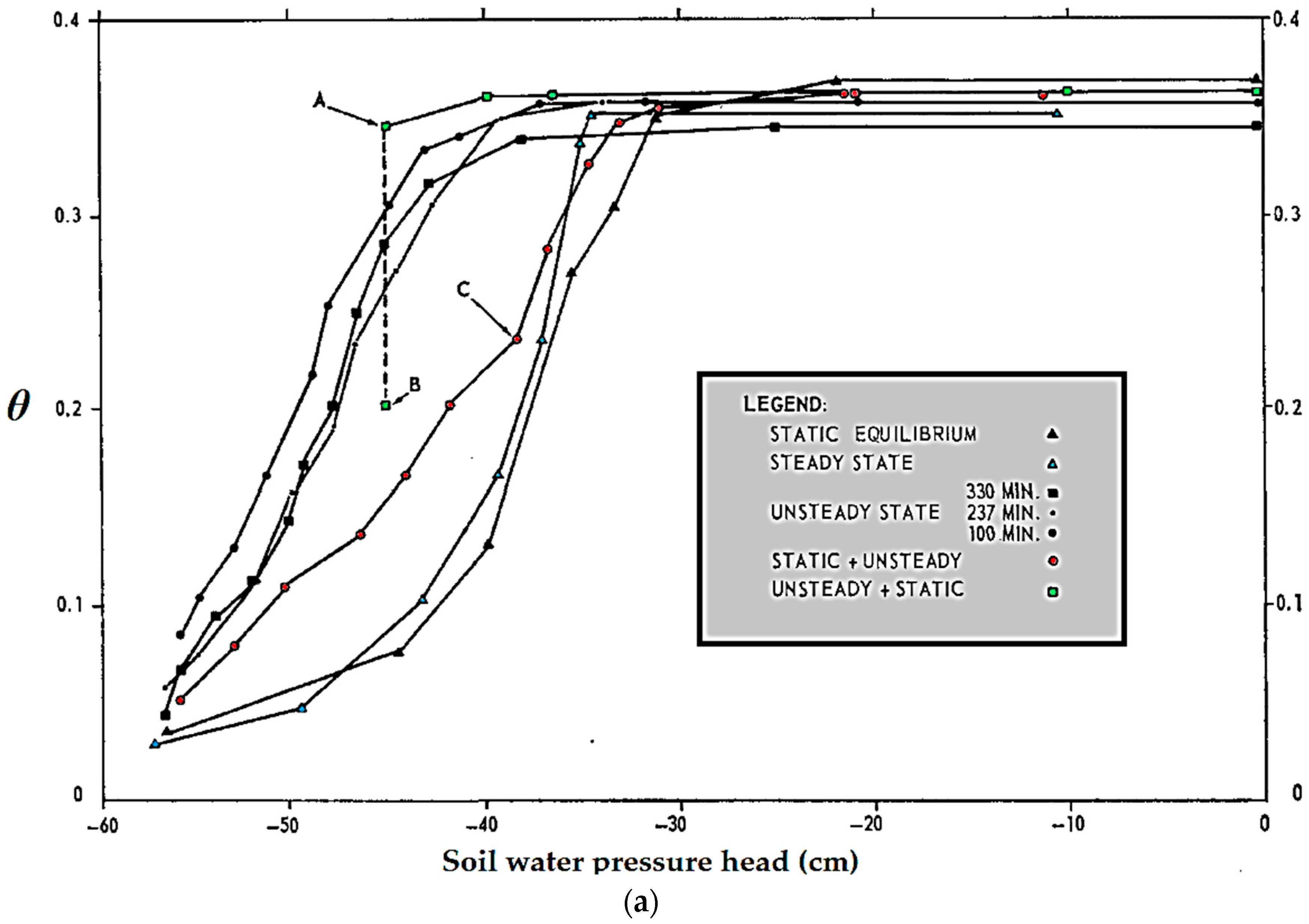
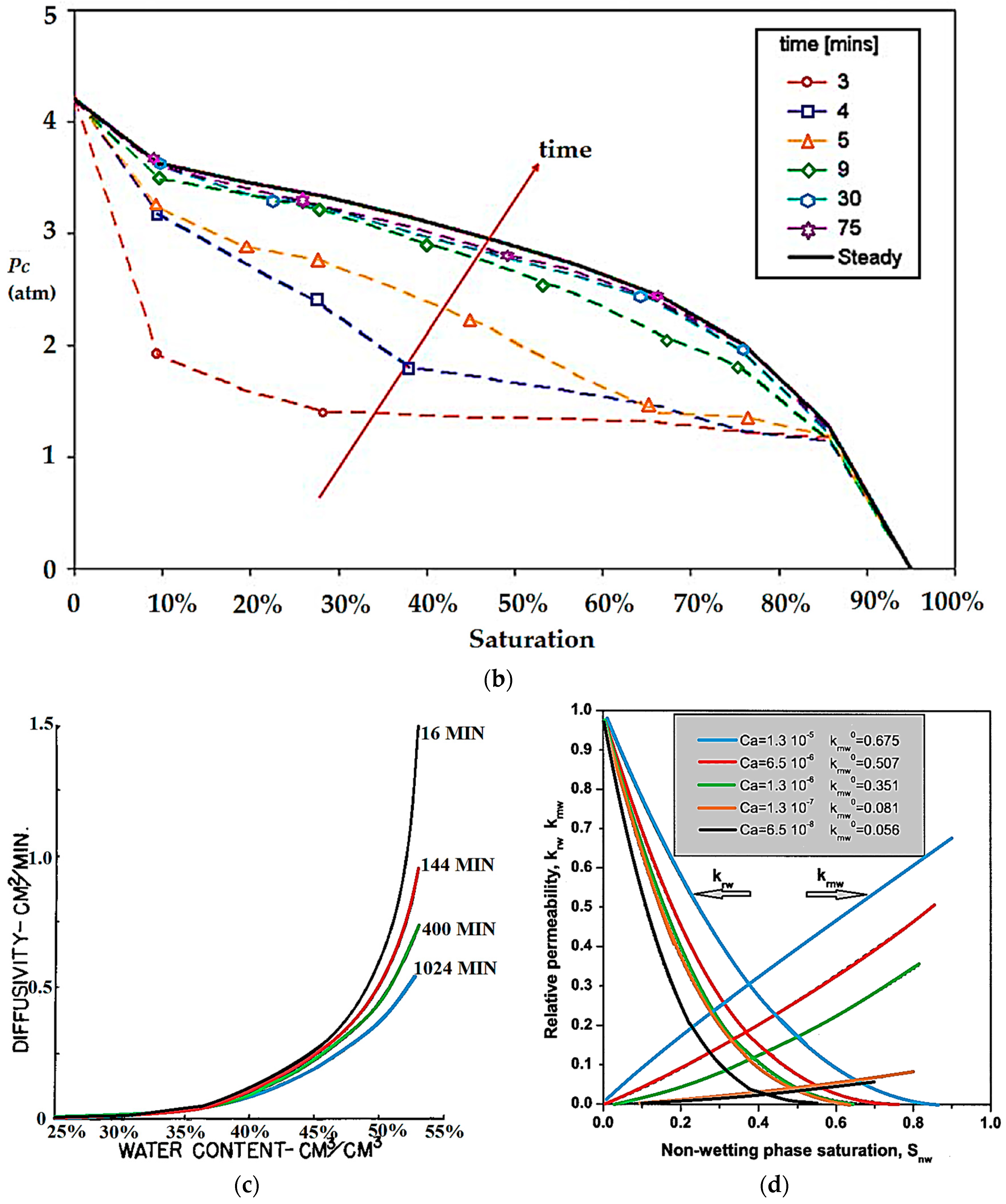
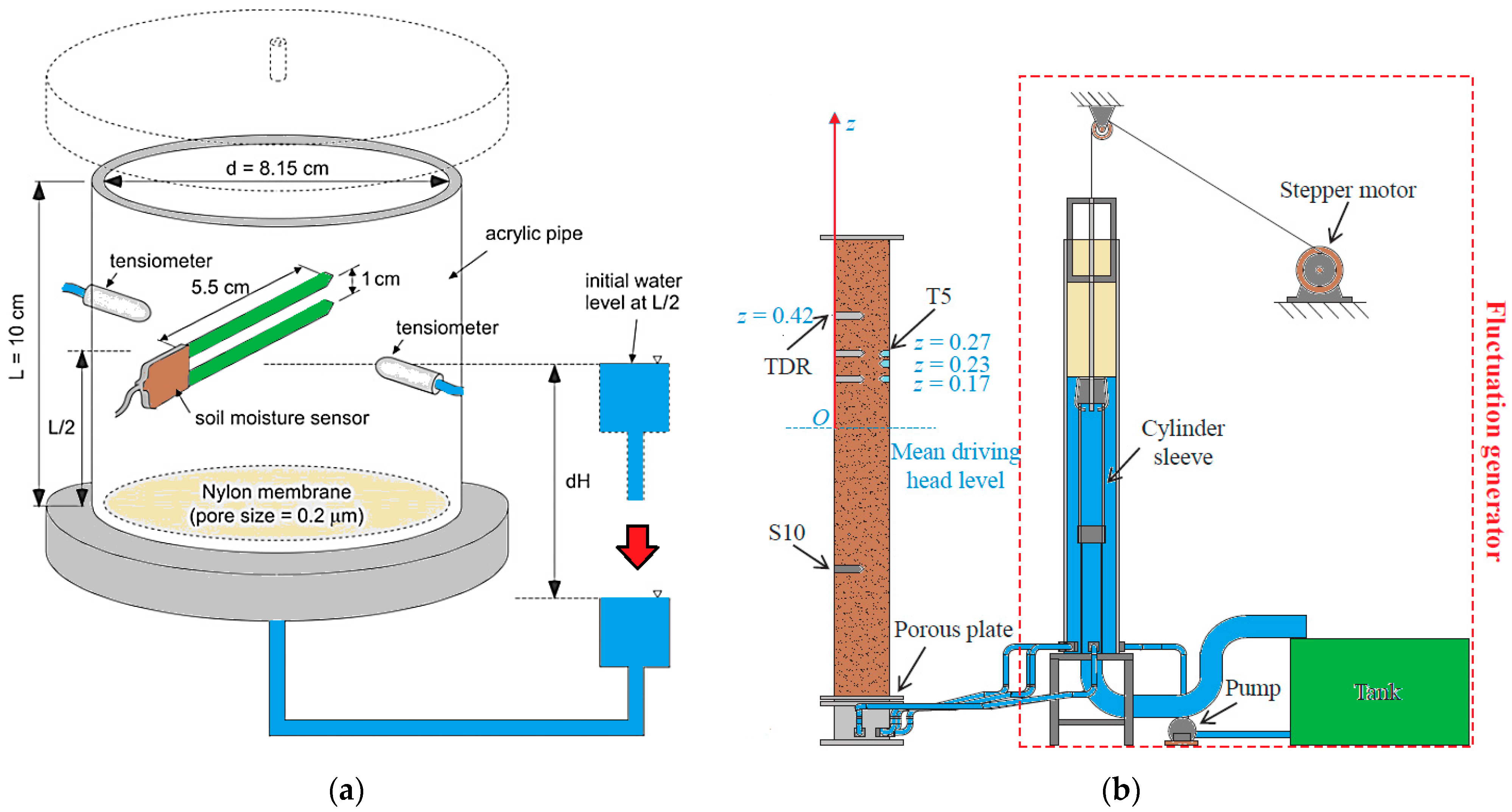
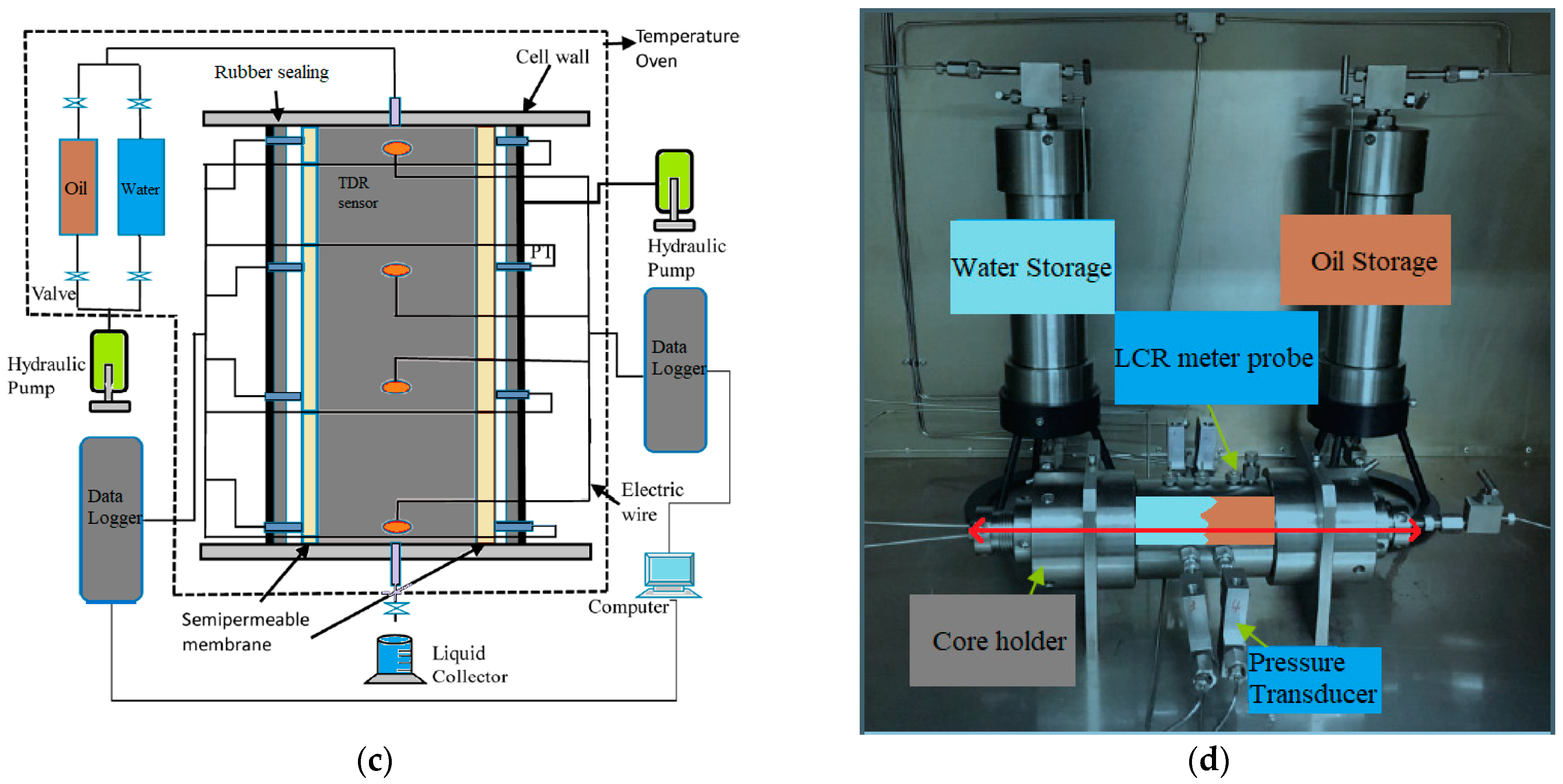
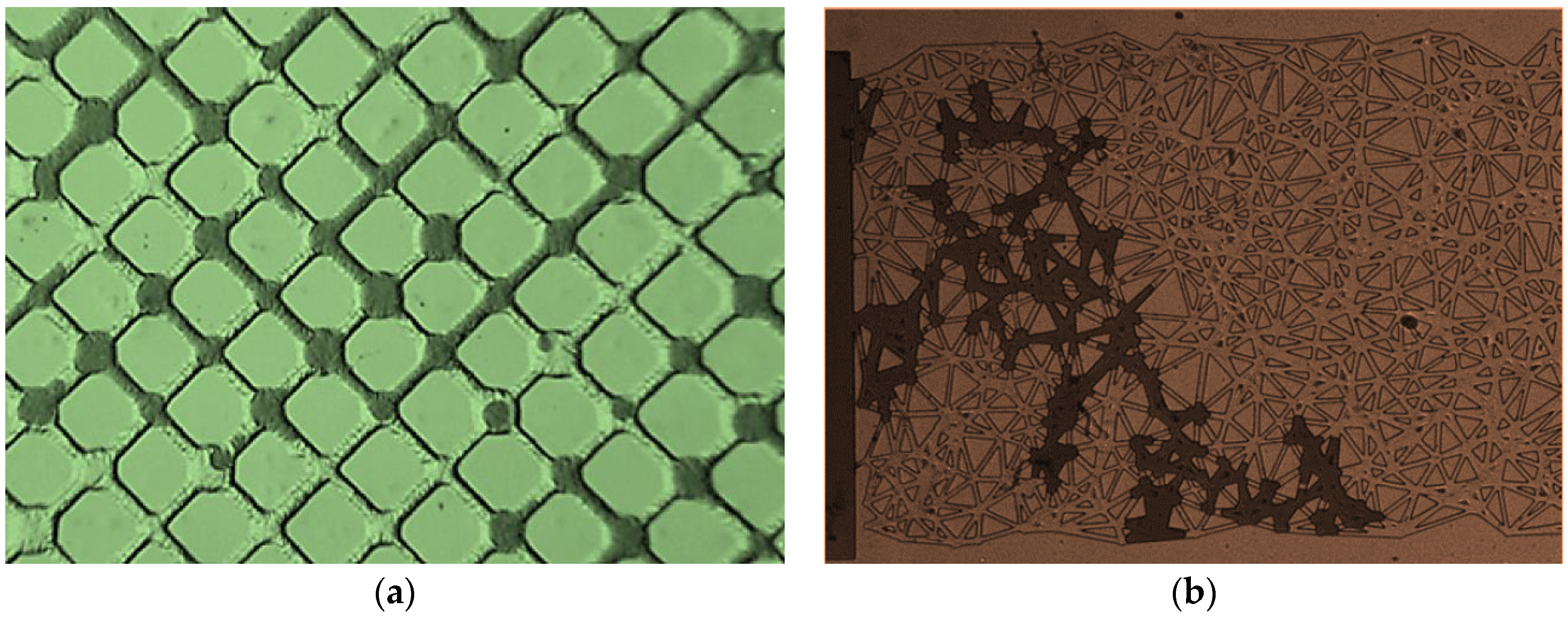

| SWRF Authors | Fitting Functions | |
|---|---|---|
| Gardner [71] | (2) | |
| Brooks [13] | (3) | |
| Van Genuchten [14] | (4) | |
| Fredlund and Xing [15] | (5) |
| Forms | PDE | |
|---|---|---|
| hc base | (12) | |
| θ base | where diffusivity | (13) |
| Mixing | (14) |
| Model Authors | Model Equations | Notations | |
|---|---|---|---|
| Childs and Collis-George [95] | (15) | Se based statistical model; Fredlund, Xing and Huang [16] rewrote it into continuum form. | |
| Gardner [96] | (16) | Simplifying analytical solution derivation but having poor-fitting performance; hc based empirical model. | |
| Brooks [13] | (17) | hc based empirical model; hcAEV = ψAEV/ρwg = air entry value in water head. | |
| Brooks [13] | (18) | Se based empirical model; BC SWRF inserted into Equation (18). | |
| Mualem [17] | (19) | Statistical model; Requiring well-developed SWRF inserted into Equation (19). | |
| Van Genuchten [14] | (20) | mVG = 1 − 1/nVG; Se based model; VG SWRF inserted into Eqaution (20). | |
| Fredlund, Xing and Huang [16] | (21) | Insert Fredlund and Xing [15] SWRF into Equation (21); Suction (ψ) based. |
| Equations | Forms | |
|---|---|---|
| Mass balance of phase i | (24) | |
| Momentum balance of phase i | (25) | |
| Capillary pressure and Leverett J function | (26) |
| Equations | Forms | |
|---|---|---|
| Mass balance phase | (37) | |
| Momentum balance | (38) | |
| Dynamic capillary pressure | (39) | |
| Equation of state | (40) |
| Seepage Equations | Mathematical Formulations | |
|---|---|---|
| Governing equation for transient soil water flow in unsaturated soil considering soil skeleton deformation (Zou, Saad and Grondin [257]) | (52) | |
| Dynamic capillary pressure (Hassanizadeh and Gray [148]) | (53) | |
| Effective porosity-volumetric strain coupling (Zou, Saad and Grondin [257]) | (54) | |
| Permeability-effective porosity coupling (Modified Kozeny-Carman Wang and Nackenhorst [260]) | (55) | |
| Dynamic coefficient-porosity and permeability coupling (Stauffer [37]) | (56) | |
| Soil water retenion fuction(Modified van Genuchten [14]) | (57) | |
| Relative permeability-saturation model (Modified van Genuchten [14]) | (58) | |
| Brooks & Corey to modified van Genuchten fitting parameters transformation (Morel-Seytoux, et al. [261]) | (59) | |
| Mechanical equations | Mathematical formulations | |
| Unsaturated soil effective stress (Biot and Willis [259]) | (60) | |
| The full pore-elastic stress-strain constitutive relationship (Biot [258]) | (61) | |
| Simplified pore-elastic constitutive relationship under isotropic loading condition (Zou, Saad and Grondin [257]) | (62) | |
| Nonequilibrium soil suction increase-induced shrinkage by assuming rigid particles(Zou, Saad and Grondin [257]) | (63) | |
| Mechanical equilibrium equation | (64) |
Publisher’s Note: MDPI stays neutral with regard to jurisdictional claims in published maps and institutional affiliations. |
© 2022 by the authors. Licensee MDPI, Basel, Switzerland. This article is an open access article distributed under the terms and conditions of the Creative Commons Attribution (CC BY) license (https://creativecommons.org/licenses/by/4.0/).
Share and Cite
Yan, G.; Li, Z.; Galindo Torres, S.A.; Scheuermann, A.; Li, L. Transient Two-Phase Flow in Porous Media: A Literature Review and Engineering Application in Geotechnics. Geotechnics 2022, 2, 32-90. https://doi.org/10.3390/geotechnics2010003
Yan G, Li Z, Galindo Torres SA, Scheuermann A, Li L. Transient Two-Phase Flow in Porous Media: A Literature Review and Engineering Application in Geotechnics. Geotechnics. 2022; 2(1):32-90. https://doi.org/10.3390/geotechnics2010003
Chicago/Turabian StyleYan, Guanxi, Zi Li, Sergio Andres Galindo Torres, Alexander Scheuermann, and Ling Li. 2022. "Transient Two-Phase Flow in Porous Media: A Literature Review and Engineering Application in Geotechnics" Geotechnics 2, no. 1: 32-90. https://doi.org/10.3390/geotechnics2010003
APA StyleYan, G., Li, Z., Galindo Torres, S. A., Scheuermann, A., & Li, L. (2022). Transient Two-Phase Flow in Porous Media: A Literature Review and Engineering Application in Geotechnics. Geotechnics, 2(1), 32-90. https://doi.org/10.3390/geotechnics2010003







